




PUBLISHER
Pawan Luthra
EDITORRajni Anand Luthra
Suruchi Sehgal
MELBOURNE COORDINATOR
Preeti Jabbal
CONTRIBUTORS






Pawan Luthra
EDITORRajni Anand Luthra
Suruchi Sehgal
MELBOURNE COORDINATOR
Preeti Jabbal
CONTRIBUTORS
Almost six months into this pandemic, very few people have a clue as to how to navigate their way out of this crisis.
tech stocks, especially the FANGs (Facebook, Alphabet, Netflix and Google) and health care stocks are up for obvious reasons. The reality of what is happening for most traditional businesses is hidden beneath the surface, as markets are awash with cheap government money. When added to the social government handouts, it keeps alive a lot of failed or failing businesses.
SALES
Charuta Joshi
Indian Link is a monthly newspaper published in English. No material, including advertisements designed by Indian Link, may be reproduced in part or in whole without the written consent of the editor. Opinions carried in Indian Link are those of the writers and not necessarily endorsed by Indian Link. All correspondence should be addressed to:
I
Level
P
Medical experts have modelled dire consequences if certain rules and guidelines are not followed. Business leaders are hoping for restrictions to ease so that they can get back to what they practice best – capitalism. Globally almost all governments have embarked on quasisocialistic policies as they try to support the public. The traditional boundaries between business, government and the public have blurred, and there seems to be no quick fix in sight.

But at some time, these band aid solutions will need to stop. In Australia with the travel, education and hospitality industries decimated, the climb back to pre-March levels will be tough. Current predictions are that one in seven Australians will be out of work - and with high unemployment, there will be pressure on the social and economic fabric of the nation. There will be challenges at almost at all levels, from the future of aged care to how childcare will work, whether our socialising will return as before, and whether face masks be mandatory for all.
vulnerable which could lead to more direct economic and subsequently political clout for China. The United States with its confused messaging and abdication of some roles such as involvement with NATO and WHO will lose its international high ground. Europe, sans UK, may well emerge as a more powerful bloc. We could see tacit cooperation amongst authoritarian regimes such as China, Russia, Iran and North Korea to counter liberal democracies such as US, India, Japan and Australia.
How this rolls out over the next decade will be interesting to observe.
G
Email: info@indianlink.com.au
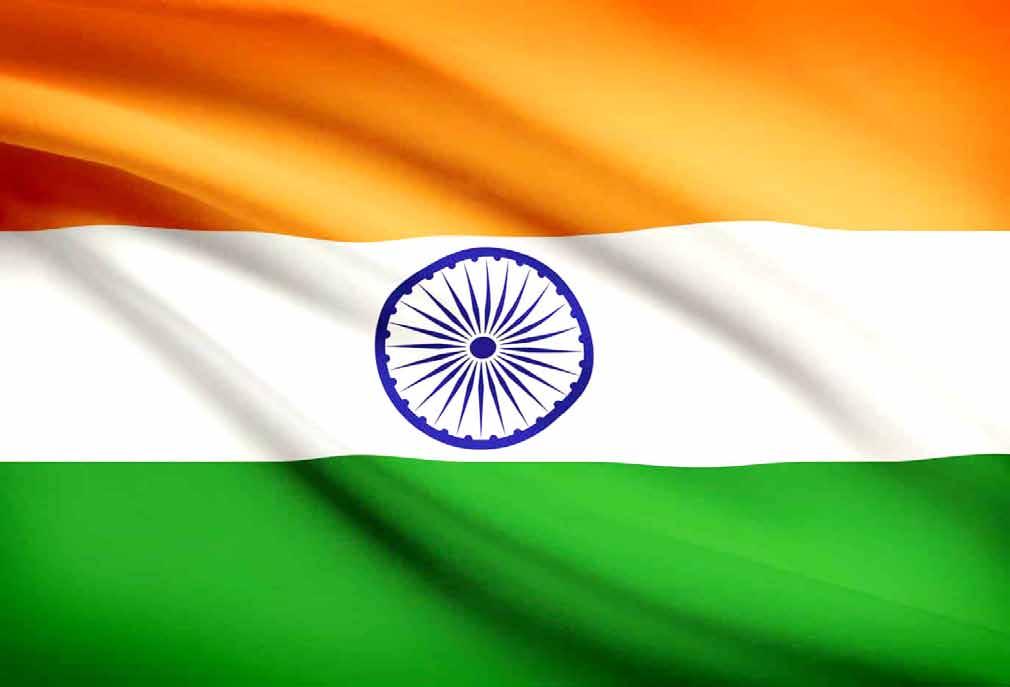

However, the share markets, which represent the collective wealth of the community, are faring well at the moment. After the sharp downturn in March, as the initial news and uncertainty of the virus hit, the markets have bounced back quickly. Disruption creates opportunities:
Globally, countries like China who on the surface of it have endured this pandemic better than others, can build up more power. They already have form in gaining influence through economic interventions. Post COVID, countries in Africa, Asia and the Pacific will be more
What will help is an early and rapid rollout of a vaccine to counter the spread of the virus. India could well play a vital role here. Currently, the world's largest vaccine-maker is Pune’s Serum Institute, which has ramped up capacity to manufacture as many as a billion doses of a vaccine in development by AstraZeneca and the University of Oxford. It’s in phase two trials in India and England, and phase three trials in Brazil and South Africa. COVID-19 will go beyond setting up new trends such as working from home or practising social distancing. Perhaps in 10 years’ time, when we look back, could this be the time when everything changed?














If you’re in the market for a new home, you know how confusing it can be to weed through the wheeling and dealing of hungry sales consultants. And with an investment of this size, you want to be sure you’re getting the best value for your money. So how do you get the help you need?
Masterton Homes recently launched an incredibly helpful comparison tool for new home builders; their Value Check Challenge. Available for download from their website or from their display offices, it lists all the inclusions that come as standard (i.e. part of their base price).





This easy to use checklist enables you to do an apples-for-apples comparison with other builders - you can keep track of what they offer, and what the value is. Simple! It’s important










to keep a reality-check on those big dollar savings offered by many builders, where more often than not, they’ve stripped back all their inclusions to make their price sound better. Once you add back in everything you need, the price doesn’t stay low for long.





When you sit with a Masterton New Homes Consultant, they will show you the value of Masterton’s Ultimate Inclusions – prepare to be suitably impressed by how much you do get!

If you’re ready, why not head out to HomeWorld Box Hill to inspect Masterton’s brand new 4 bedroom display home, the Harmony Exclusive. At just over 29 squares, it’s perfect for families looking for a smart layout in a single storey home design, that doesn’t compromise on luxury. Open 7 days a week, the Harmony Exclusive is displayed with the impressive new Palm Springs façade, a sure-fire winner for street appeal.
It’s no wonder the Harmony Exclusive’s floor plan is a popular choice. You can feel it right from the moment you enter. Entertaining for large family gatherings will be a breeze. Meal preparation is supported by luxury European appliances, and a walk-in pantry keeps the clutter away. The heavenly raked ceiling is icing on the cake to the open plan living. Large sliding doors let in
natural light, and allow for effortless transition between indoor & outdoor living.


The home theatre will keep the sports fans, gamers and movie buffs happy, and a separate sitting area is perfect for those needing some quiet time. The remaining bedrooms are perfectly positioned back from the main living areas, and have their own hallway. There’s plenty of storage space, and a laundry that can handle everything a busy family throws at it.
So, if you’re ready to be the envy of your neighbours, then don’t wait a moment longer. Our resident New Home Consultant, Priyanka Thakur, is waiting for your call on 02 9821 9780 or 0406 414 730.
Here’s the quintessential tool to help every new home builder... and it’s free

In our video series Long Story Short, Harinder Sidhu, former Australian High Commissioner to India, reads to us from a book by an old friend Navdeep Suri, former Indian High Commissioner to Australia.

Navdeep Suri wrote: A big thanks to Harinder Sidhu for such a beautiful rendition of Khooni Vaisakhi. I hope it encourages more people to read the book. And compliments to Indian Link for such a great initiative.
Latha Reddy wrote: A beautiful tribute. Lest we forget
Rajni Anand Luthra wrote: Took me straight back to Jallianwallah Bagh which I visited not so long ago. Thank you Harinder Sidhu for drawing our attention to his book and Navdeep Suri for writing it. Hope it inspires more such work – and many more translations.
JYOTI SHANKAR wrote about Chokey Nuroo, the founder of Tasmania’s famed Lufra Hotel, who arrived in Australia from Kolkata in the late 1800s.

Pheroza Daruwalla wrote: Thank you so much for the wonderful story on Chokey Nuroo. Simply loved it and am sharing it. Thanks Indian Link for keeping us informed and entertained.
Nisha Chaman wrote: What a fascinating story. Not the rst time a Kolkata lad has arrived in Tassie and made a splash (Saroo Brierley of Long Way Home fame, I’m looking at you!) Wonder if the writer Jyoti Shankar could tell us more about Chokey’s descendants. Do they still go by the name Chokey? Or Nuroo?
RAJNI ANAND LUTHRA reported on brothers Neil and Nikhil Reddy who spent their winter break involved in a charitable activity.
Foodbank Australia wrote: Onya boys! Thanks for helping us ght hunger.
Phyllis Stylianou (Of ce of the Mayor Burwood Council NSW) wrote: I read with interest your article about the Reddy family of Strath eld and their sons’ food drive for FoodBank. Our mayor would like to congratulate the boys on their wonderful efforts to help others.





Barry O’Farrell Aust High Commissioner to India wrote: What an incredible story of two Indian boys who spent their locked down school holidays fundraising for Australia’s largest food relief organisation Foodbank. In a week, they collected 168 kg worth of donations from their neighbourhood.

Julie Owens MP wrote, correcting Barry O’Farrell: Australian boys!
Stage 4 restrictions mean no takeaway coffee. In Melbourne. There'll be people coming up to you on your walk, whispering "what do you need? Ethiopian single origin?
Arabica? If you give me ten minutes, I've got a guy who does cold brew..."
Adam Rozenbachs @arozenbachsA oating pillar? Yes, that’s right! We asked you to identify this ancient Hindu temple.
Readers Raj Saneja, Sweta Shah and Archana Preeth Sagar got it right: it’s the the Veerbhadra Temple in Lepakshi, Andhra Pradesh.The hanging or oating pillar is believed to be a miracle – if you are able to pass an object through the gap, such as a piece of fabric, you will be bestowed with good luck.

Empty toilet paper shelves can lead to only one thing: a rise in poo jogging.
Mark Humphries @markhumphriesBeing an Australian in quarantine is just *eats a woolies mud cake* *cries* *watches scomo talk shit* *bangs head against wall* *sees trumps electability rise* *sleeps* *eats a whole bag of shapes* *watches no one give a shit about healthcare workers* *bangs head against wall* *watches people go to beaches* *curses* *cries* *bangs head against wall.
@wonder****
You liked our post about six-year-old American child Bridger Walker who saved his sister from a dog attack and ended up with 90 stitches to his face. Days later, the siblings marked the Hindu festival of Rakhi.


Dmonweb wrote: Wishes for Bridger’s recovery. This is a beautiful post.


Selvarajoo227 wrote: Proud of you for (showing) courage.

Diversity At Play (New Jersey USA) wrote: Happy Rakshabandhan.
Elvina Das wrote: A true example of the essence of this festival #happyrakhshabandhan.
Varun Rao wrote: What a brave little boy! He should also be given the bravery award.
Sashi Robinson wrote: Quick recovery you brave man.
Aarti Aggarwal wrote: Brave little brother. Hope you get well soon.
Harnoor Boparai wrote: Brave lad.
PREETI JABBAL brought us the inspirational story of 50-year-old Parvinder Chawla, known as Wheelchair Wonder Woman. She toured Australia late last year, her 59th world destination.

Sonia Batra wrote: Parvinder is truly an inspiration.
Jyotika Singh wrote: What a marvellous journey, Parvinder Chawla. We’re all suffering in these tough times especially in Melbourne, and reading something like this reiterates my faith, and the belief that it’s going to be ok. Life is still good, and we have much to be thankful for.
Gurcharan Singh Gandhok wrote: What a champion.


Will Dan Murphys be open in stage 4?
Harley @ hd eld7
Anybody else up to 6 meals a day?
Anna
Nonymous @ osoplain
Nelson Mandela spent 27 years in solitary con nement and complained about it less than some of those people in Stage 4 lockdown.
Jo Didley @jot_au
A world-famous snorkelling spot set against a dramatic shipwreck up, how exciting! Readers Kalyani Sriram and Krish Murthi correctly identi ed it as the Tangalooma Wrecks in Queensland.

Should religious and political leaders be off-limits in jokes made by comedians?
Yes, they should be excluded out of respect. 29%
No, it’s a part of the comedian’s freedom of speech. 71%
Do you think face masks should be made mandatory while stepping out of home?
Yes, masks can prove to be effective if used correctly. 65%
No, masks make no difference. 35%
That feeling when you change from your day trackies to your night trackies…
Dani Valent @ danivalent
Adelaide has had an 8pm to 5am curfew for the last 184 years.
Ares Mars @AresMarsFlack
Well at least my years of being an introvert with no social life and very few friends has prepared me well for Stage 4 lockdown.
Bianca Fileborn @snappyalligator

Even as the world around us has turned decidedly grimmer, our Independence Day special is a light-hearted take on all things Indian.
We asked our readers to send us what screams ‘India’ to them, and we were flooded with responses. An incredible variety that reflected the vibrancy and dynamism of the country (and to be honest, made us a bit sentimental too!)
AMUL


As far as brands and marketing go, India's Amul butter tops it all. With its tagline 'the taste of India', this 'utterly butterly delicious' dairy item is a household name. Amul's branding has been part of India's cultural landscape for decades. Its innovative advertising is one of the longest running campaigns in the world and it continues to appeal and assure. Cheeky and amusing, the Amul girl has managed to keep her fan following intact since her inception in 1967 by Sylvester De Cunha, Eustace Fernadez and Dr Verghese Kurien. India's most recognised mascot is used to mobilise comments on all national and political events with its signature humour.
The diversity of our list clearly indicates that emotions ran deep and wide. Sometimes expressing them needed the dexterous use of Hindi too. Kyon ki kuch shabd Hindi mein hi achche lagte hain!
From patriotic fervour to favourite foods to savour, from the spiritual to the sublime, from traditions to trends, from the heart of India to its hidden corners, we explore everything uniquely Indian from A to Zee.
If any or all of them put a smile on your face, our job is done!
Big, beautiful, soft and fluffy deep-fried bread paired with scrumptious tongue tantalizing chanas
If this doesn't scream orange, white and green (and don’t forget the blue!)
I don't know what else does. Some argue that beer is the life blood of a nation, others insist that sport is. With India, it all boils down to two simple things - good food and good times. Two great things matched only by the soul satisfying union of Bhature and Chane. Soul food, one could even call it! Lavish textures and sumptuous flavours are what make bhature and chane an icon of Indian cuisine.

Everyone loves a good Indian curry. A great way to present meat or vegetable dishes, a generous variety of spices and herbs go into the making of each. There’s a curry from possibly every state in India, from Uttar Pradesh right down to Kerala. The ingredients and their permutations and combinations - and the delicious resulting flavours - are so many in number that you could eat a completely different style of curry every night of the year (just ask ScoMo!) If you haven't tried an Indian curry yet, what are you waiting for? Wait, IS there anyone who HASN’T tried a curry yet…?

There are a bunch of Indian items that can come to mind, from delicious dosas to the enticing dandiya, but there’s an important D word we too often overlook: democracy! It’s easy to take for granted that India is the world’s largest democracy, but it also means that all citizens are seen equally irrespective of religion, gender, or caste. In recent years, there has been a wave of disagreement about how (or whether) this has been put into practice. In times of doubt like this, I find comfort in looking back at the founding ethos of India, one enshrined in equality, solidarity, and another important D worddiversity.

E is for education. Often mistaken for Literacy! My motherland’s denizens have a visceral faith in the power of education to transform lives. It is heartening that the poor share the education ethos with the rich. If anything, perhaps with more conviction! Whilst all of the above is highly encouraging, Indian education needs to foster a more civil public discourse, the cultivation of a scientific temper and rising rationality. For far too long, there has been an emphasis on rote learning rather than independent thinking.
I am optimistic that Education will be the underpinning of India’s era as one of the Superpowers of the next 100 years.



Like most of us, my best childhood memories are of the festivals that were celebrated in the community with much enthusiasm and vigour. Those were such fun times - as we took part in all festivals regardless of their religious background! Some of the major festivals went on for days and I used to get involved with various cultural activities such as stage performances, dances, sporting activities etc with my mum. Of course no festival starts or ends without food! Festival-Food-Fun-Fair-Friends 'n' Family. Nothing brings people together like festivals. Festivals help us to keep connection with our culture, and to preserve it.





The longest river in India, the iconic Ganga (Ganges) supports millions of lives and livelihoods along its long course. On its route after it has descended from the Himalayas, Hardwar and Hrishikesh are must-visit holy spots for Hindus. Crossing the majestic river in the literally swaying-in-the-wind Laxman Jhoola, as well as by an equally rickety motorboat, the huge expanse of the river and the strength of its current always stunned me. The freezing temperature at Har Ki Paudi is amazing even on hot summer days. Fond memory – taking the traditional dupki (dive) with my brand new bride. Fascinating Ganga Maiya.
Straddling the border of the world's two most populous nations lies the mightiest of all natural landmarks on earth, the Himalayan mountain ranges. It was created by the collision of tectonic plates when the Indian plate merged with the Eurasian plate over 70 million years ago. My personal experience with the Himalayas involves the time I spent in the hill station city of Shimla, capital of India's Himachal Pradesh. I used to wake up every morning to the sight of vast snow-covered peaks while still experiencing life in an urban environment. I shall never forget the time I spent in my great grandmother's house nestled at the foot of the mighty Himalayas.






Having been born in Delhi, but brought up in Bombay, one of the most common mistakes I made as a child was to call the Gateway of India, India Gate. As a 10-year-old up until now, I always wondered why I confused the two symbolic structures?

Was it the memories of those ice cream trucks? Rolling on the lush green lawns? Or watching the Republic Day celebrations with pride.
In hindsight, my attachment to this icon is perhaps bounded by family-centered sentiments. I distinctly remember them being memorable family excursions and watching other families also enjoying themselves.

This one iconic word is what keeps India going. We don't believe in design or planning: when push comes to shove, we somehow manage to get things done. You ask how? Jugaad!
Some may call it a derogatory term for improvising, but we take no offense. Hey, we wear our jugaad -a-bility with pride.
We'll do the job but don't need the tools. Want to talk while riding on your bike but don't have headphones? Simply wedge the phone between your face and helmet.
Jugaad is not a fallback or alternative to the proper way of doing things. Often it is the only way of getting things done.


My favourite shopping trips of the year were always for those majestic, embroidered, colourful lehengas with their matching cholis.

Every year, I would steal gold bindis from my mum’s drawer (sorry, Mum!) and go to M Block Market in Greater Kailash II in Delhi to pick out lehengas. Best of all, they would suit every occasion, whether it was the wedding season, Diwali, or even for Dusshera. Lehenga cholis are such a graceful symbol of celebration, of family, of coming together as a community to rejoice. To me, wearing one of these is inherently associated with happiness and good memories.

M is for mango... but not the supermarket kind. It’s the childhood summertime ritual of going to the fruit-wallah with Baba, and sniffing the top of each mango deeply to select the ripest and juiciest ones from the pile. M is for that magical aroma.
It’s about raw mango robbery from the neighbour’s tree, and then biting into that shudder-inducing sourness, and those pleasurable bellyaches (from eating too much mango or laughing too much with friends, I don’t know). M is for that masti. It’s about the discovery of the last little bit at the bottom of Ma’s mango pickle jar, and realising that you can indeed bottle time. M is for those memories.

Abdul Kalam. The missile man of India. The man who propelled India into the elite space club. The man who everyone unanimously refused to hate - the people’s president. Kalam shared his vision of a technological India and inspired many to embrace science for the general welfare of the nation. Among the millions he inspired, I humbly present my tribute to the great man. While Kalam's unending list of scientific achievements and honorary awards come to mind for others, Indians embrace his innocent smile which, even after his demise, still has not and never will fade from our hearts.

Dancing, or Naach gana as we call it, is India's favourite pastime. No Indian event or celebration is complete without some form of dancing, whether Bollywood, classical, traditional, DJdriven or some drunk uncle balancing a drink on his head. We dance for weddings, during cricket, at birthdays, on the street, in the pool, even while driving. We made TikTok popular with majority of its viewership coming from the subcontinent. What kind of content did we add to these social platforms? You guessed it - dancing. Aunties dance; kids train to shake a leg; dolled up girls show sexy moves; heck, we even got David Warner grooving with his family.

Mythologies always amuse me. Onam, a cultural festival from the state of Kerala, recalls a dream-like egalitarian country, ruled by a remarkably just, but Asura king. Even Devas, the Gods envy the prosperity he brings to the country.

I am fascinated by the way mythologies are intentionally woven into the social fabric to maintain peace and tranquillity. To me, India is beautiful because its every nook and corner is vivid with myths and stories. As a cultural studies student, it is lovely to see how the Indian diasporic community celebrate these stories and festivals and recreate our rich cultural roots. As we celebrate Onam starting from 22 August, I wish everyone a happy Onam.

Rishtey-naatey. There’s perhaps very few other words that embody the spirit of being uniquely Indian. Growing up in India we have all experienced an abundance of rishtey-naatey. Our relationships were not limited to our immediate family and friends, but they extended to relatives and friends that we met at our 1000-2000 guest weddings, which in turn were not necessarily in our town of domicile but all across India. Even today we savour our relationships that were made during train journeys. No wonder we never felt the lack of social media and the need to invent a Friendship Day!
Just the word brings memories flooding back of friendships (and perhaps connections that led to girlfriends) at the nukkad, neighbourhood corner, the epicentre of all breaking news! How I wish we had this culture in Australia. We would not need WhatsApp and Facebook to learn the latest gossip or acquire the latest news. The famous Indian immune system was perhaps enhanced when the Paanwala bhaiya with his long thick moustache used his fingers to apply chuna, kathha and various other condiments that made what Paan is – an explosion of lovely flavours and tastes – the epitome of after dinner mint!


India, hunger and Sachin Tendulkar are inseparable. That's why Allan Donald once said, "I don't think I've seen a hungrier batsman than Tendulkar."

India in the late '80 and early '90s - a country of 600 million rife with terrorism, corruption, sectarian violence, drought - was in labour pains for a hero to be born.


I first saw Sachin in 1991, on an old B&W TV. His boyish charm, humility and dreamy demeanour taught India to go beyond religious and linguistic divides, and made dreaming affordable for teenagers like me. Tendulkar will always remind me to dream, and to focus.
For me, Qawwali is the reggae of the Indian subcontinent. Infused with romance and soul, I loved it from the day I saw Nusrat Fateh Ali Khan croon the song Afreen Afreen on the television screen. Even without music videos, it was a delight to hear it as a teenager when a Sufi band from across the border visited our school, and when a kurta -clad young man busted a tune in the middle of Delhi Haat. My now-husband played an original Nusrat qawwali in his Sydney apartment on our second date… and the rest is history.



The name Tata is synonymous with quality and reliability. Getting a Titan watch as a gift from the parents was a badge of honour worn proudly. A jewellery from Tanishq for the wedding was a must. In school, I remember learning about India’s first planned industrial city Jamshedpur, founded by Jamshetji Tata. Whenever I visit India, in the kitchen I see Tata tea, coffee and spices from their brand Tata Sampann. It is hard to fathom that a company that started as a small trading company in 1868 by Jamshetji Tata, now has more employees than Toyota, Coca Cola, Facebook, Microsoft and Google combined.

GAYATRI





Trailing the colours of the national flag - Orange, White and Green - let's stand together for unity.
Let us say with pride: Hindu Muslim Sikh Isaai, Aapas mein hain Bhai Bhai.




Let us not take our independence and freedom for granted.

Let's take a stand against divisive forces in our society, and forge a common path to peace and prosperity. May this Independence Day fill our lives with health, happiness and peace. On this special day, here's wishing our dreams of a new tomorrow come true.
Jai Hind!
The letter X is a tough one but there’s one iconic word that I’ve recently learned from India that starts and ends with X - Xerox. Currently homeschooling, I hear this term frequently. Every time I need to photocopy something, Mom and Dad say, “Xerox kar lo”. Had NO idea what that meant, till they explained it to me. Apparently the first photocopying machine that became famous in India was called Xerox. The branding was so strong that people associated photocopying with Xerox. The name stuck so much that everyone now calls every photocopy machine Xerox, and even make a verb out of it, as in ‘Xeroxing’. Now when they tell me “Xerox kar lo” I know exactly what to do.
This is a phrase that evokes multiple emotions no matter which part of the world an Indian lives in. Its origin is traced to 1875 in a poem written by Bankim Chandra Chattopadhyay to praise Mother India. It raised a feeling of nationalism and became an integral part of the Independence movement. The poem was first sung by Rabindranath Tagore in 1896. It subsequently became the national song of India in 1950. The phrase itself has two elements that I respect and revere: mother and country. I still feel goosebumps whenever I hear this phrase. I absolutely love musician A R Rehman's adaptation of it in the song Maa Tujhe Salaam – it never fails to leave a profound impact.

If you haven't had the pleasure of being a part of a big, grand Indian wedding, you’re missing out! Spanning anywhere between three days to over a week, this grand celebration of love becomes a perfect amalgamation of tradition and modern culture. You’re exposed to Bollywood music and dance, venues decorated in a variety of colours, and of course, Indian food at its finest. It’s also a beautiful experience to share the celebrations and ceremonies with the hundred(s?) of other wedding attendees. It’s an event that everyone should be a part of, at least once in their lifetime.
Yoga - it is India’s gift to the world for healthy living. It’s a form of exercise that’s rejuvenating for both the body and the mind. It boosts strength, flexibility, immunity, posture…

There’s even an international day to celebrate it! In my opinion, yoga is a great example of how ancient techniques used by our ancestors are now creating a huge impact around the world. (Of course, our generation can be stubborn, and we’ve only recently started to warm up to it.) Let’s hope we don’t end up learning all our ancient techniques from western culture!


The rich grainy soil was an earthy brown - there was the distinct essence of smoke and pashmina that wafted to me. As the robust Indian earth drifted through my hands it reminded me of the vibrant and iconic culture that had been birthed upon the very place I was standing. The decadent taste of the spinach which had been cultivated nearby, the ruckus of fanatical truck horns mixed with tires treading across the barren dirt and the pitter patter of children running around outside their houses. So much beautiful history had been forged upon this ground and despite the crudeness and roughness of it, whatever happened here was something to marvel at.





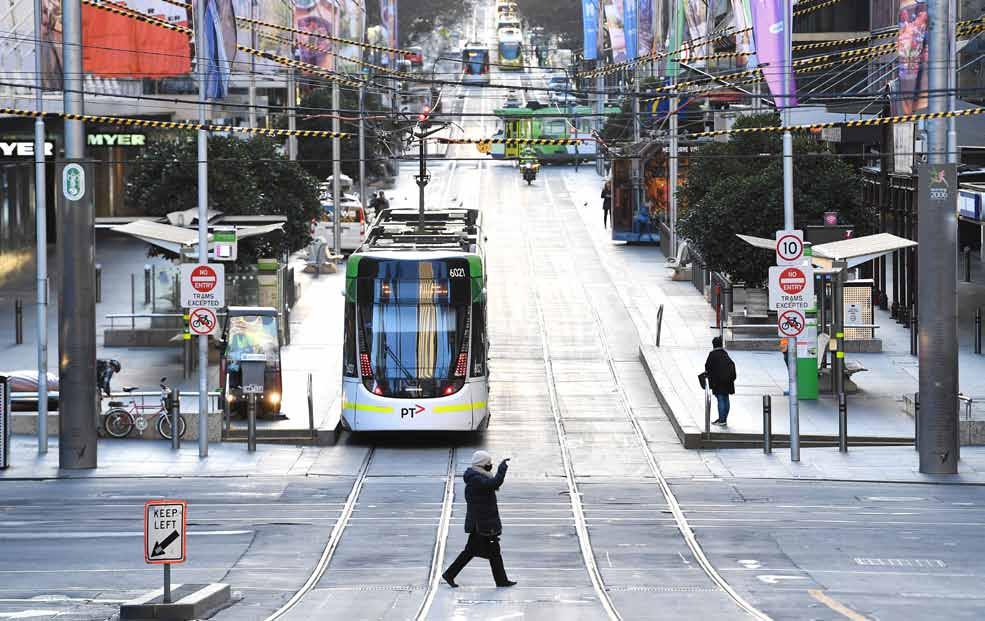 BY PREETI JABBAL
BY PREETI JABBAL
Over 130K Victorians have just finished registering for a social media initiative, started by Christian Bernstein, to send Premier Daniel Andrews a virtual hug. He is, undoubtedly, in the worst position possible, leading a state through a pandemic. The exhaustion is now clearly showing on his face during the regular COVID-19 updates.
On the other hand, many people have lost faith in his leadership and pandemic-related decisions. Some went as far to suggest giving his wife a chance at the leadership as she may do a better job considering her gender and ability to multitask.
From bungling of the hotel quarantine to permitting the Black lives protest, the Premier is under fire for several of his decisions.
Academic Meenu Shrivastava, however, is quick to defend the Premier. “No current leader has prior experience of dealing with a pandemic and mistakes are bound to happen,” Meenu said.
“Can all those complaining about the harshness of Stage 4 restrictions and its effect on the economy provide any better solution? Why blame the premier
for people not doing the right thing? Driving the numbers down is crucial or these restrictions will have to continue indefinitely, forcing us further back in our attempt to stabilise,” said the University teacher who is running online tutorial sessions from home.
Restaurateur Dilpreet Singh, on the other hand, is very unhappy. “This second lockdown is going to hit harder with my business suffering 80% loss of incomings. I do not see any point in keeping things open and pay for staff, electricity, groceries etc. when hardly anyone comes in,” Dilpreet said in desolation.
“We now lock up at 8 PM as no one comes in during curfew times to pick up orders and if we rely on delivery chains they take up a substantial chunk from every order leaving not much for us to survive on. This weekend’s foot traffic will be the deciding factor on whether we cease operations temporarily or persist on dismal income,” he added sadly.
The meat industry, warehousing and distribution, retail, education and construction sector are all affected with the Stage 4 lockdown. Unemployment is on a high and thousands of workers are without jobs. The flow on effect of these industries being scaled down is causing further speculations, none of which is reassuring.
“Truthfully, I never thought I’d find myself in a position where I’d have to ask people not to go to work,” said Premier
Andrews recently. “But right now, that is exactly what we are asking of so many Victorians to help slow the spread of this deadly virus.”
According to the Premier, the decision about where to draw the line on different categories of jobs can never be simple or easy, yet there is no alternative but to take these steps. We must take unprecedented action in limiting the movement of people, and therefore limiting the movement of this virus - to do otherwise would be deadly.
The anti-lockdown protestors and anti-mask conspirators, however, are not with him on this. They wish to fill up the streets to show that they will not give up their livelihoods without a fight. From allegations of violations against human rights to questioning whether the pandemic is infectious to refusing to wear masks, these protestors and groups are actively using social media to show their rejection of rules and restrictions.
Pavan Cheema, Executive Director of Oilseeds Australia, firmly believes in adherence to the advice provided by Public Health experts. According to him these experts are charged with the responsibility and have the knowledge and access to information that is required to make informed decisions. This, he said, also makes the public officers and the Premier answerable to the public.
According to Pavan it is imperative that the policy makers proactively provide
clear directions to different interest groups through a simple campaign that takes the message to the larger public. “They need to be two steps ahead instead of playing catch up and they need to make sure that mistakes are not repeated,” said Pavan.
“All this clamping down is a bit late, I think, but necessary,” feels Simmi Kaur who works in retail and has been told they would not be trading for six weeks. The company she works for is yet to communicate the plan for its employees and her future is uncertain.

“When the first set of lockdowns occurred in March we all enjoyed the novelty of staying home, catching up with chores and relaxing with family. The second and third stage were still ok as they allowed for some movement but with these latest restrictions, it is going to be a long six weeks,” she lamented.
“I have mixed feelings about this as there is no guarantee that numbers will reduce and what exactly is acceptable level? How low is safe enough for the economy to get back to normal? I do not envy people who have to make these hard decisions, but the way things are going it undermines my confidence in them to some extent,” claimed Simmi.
“Someone just sent me a clip of a wrinkled Daniel Andrews announcing the 129th lockdown where Victorians are urged to remain in bed. It’s funny but scary too as there does not seem to be any light at the end of this tunnel,” she ended.






































A year after swimming the english Channel, Abhishek Malik’s fundraising efforts see no stopping
BY SHANIA O’BRIENIn 2019, Abhishek Malik became one of a select group of people who have swum the English Channel.

The fifteen-hour, 32-km distance has only been conquered so far by 230 Australians and 55 Indians.
Malik though, was driven by something far too strong – the fight against cancer.
As a survivor himself, he was swimming to raise funds for CanTeen, a national support organisation for young people aged 12-25 living with cancer.
But that was not the end of his philanthropic endeavours. As a 26-year-old today, Abhishek has aged out as a CanTeen patient member, but remains a youth ambassador. He also continues to volunteer for them, helping out with events like National Bandana Day, a major fundraising event held on the last Friday of October annually. National Bandana Day has raised over 30 million dollars for CanTeen.
Abhishek believes he has found his niche in channel swims, and definitely has “intentions of participating in more fundraising.”
He aims to cross the Catalina Channel, a 30-km swim from Santa Catalina Island to Southern California, but plans are currently up in the air thanks to the pandemic.
Currently, though he is training for the ‘Iron Man’ triathlon, which includes a 4-km swim, 180-km bicycle ride, and a 42-km run.
Abhishek laments that in the South Asian communities, cancer has much stigma attached to it. One of the reasons he has wanted to talk about his swim last year is so that other Indians who are going through the same experience would feel less inclined to shy away from talking about it.
“A cancer diagnosis is not something to be ashamed of, it just sort of happens. It’s
unfortunate, and it’s bad luck, but it’s life.”
Abhishek recalls that during his own recovery process, people were often afraid to bring up the ‘C-word’ and referred instead to his ‘illness’.
“No one would directly address my cancer,” he says. “I say cancer in general is something that we must talk about more and more.”
Back in 2016, Abhishek, then 22, was diagnosed with tongue cancer. It came as a shock to him.
“I was a healthy non-smoker young adult,” he tells Indian Link. “The diagnosis came out of nowhere.”
He spent the next year in and out of
hospital, undergoing surgery first that left him bed-ridden for two weeks, and then radiotherapy daily for a month.
“During the process, I had a lot of time to think,” Abhishek ruminates. “I was at home, isolated, with a lot of time to reflect on where I was in my life at twenty two.” This was when he decided that he wanted to do more to give back to society.

Once he started to recover in mid-2017, he gave himself a year to regain his strength. “I’m still not the same physically,” he reveals.
In early 2018, Abhishek decided he wanted to raise funds for CanTeen by swimming the English Channel. When asked about why he chose this specifically, he said that he wanted to do “something big,” and that anything smaller would not have done justice to the year he had surviving cancer. Abhishek wanted to prove that he had made it through and take advantage of what he had.

“I’ve always been an average athlete,” he admits. “Nothing extraordinary.”
Having enjoyed swimming at school, Abhishek picked this over other adventure sports like mountaineering for his fundraiser.
Ten months of intense training at Sydney’s Manly and Coogee beaches followed.
When he finally crossed the English Channel in August 2019, he had raised $22,180 for CanTeen.
access to mentors, assistance with job applications and advice on remote working and wellbeing.
BY KHUSHAAL VYASOver the course of many decades, migrants to Australia have made major contributions to Australian culture and the community – in hospitals, through charity and in business. Despite this, it seems Australia has taken a step backwards with regard to ethnic diversity in the workplace. Earlier this year, a Lawyers Weekly article even found that whilst female leadership on business boards had improved, ethnic diversity had, in fact, shrunk.
Keerthi Ravi, a Senior Associate at one of Australia’s largest law firms, says, “As a culturally diverse woman, I am always surprised at the lack of diversity in the legal sector: whether at law school, in a meeting room, on the office floor or in a courtroom.”
To her, the lack of diverse women in the workplace was clear.
This inspired her to create Diverse Women in Law (DWL), a Sydney-based non-profit organisation aiming to empower and support female lawyers and law students from diverse backgrounds.
“Despite being from a minority background, I still consider myself as coming from privilege,” Keerthi told Indian Link. “I've had the benefit of good mentors and role models at uni and in professional

endeavours. It dawned on me that the profound impact it has had on my successes to date isn't something that's necessarily available to other diverse women.”
In the space of just one year, DWL has grown from Keerthi’s brainchild to over 800 members across Australia, featuring some of the most powerful and influential lawyers and judges in the country.
DWL’s inaugural mentoring program had 120 participants, implemented on a 2:1 (mentor to mentee ratio) basis.

Other activities have involved formal on-campus work with students, and more informal discussions between students and early career lawyers in its “Cuppa on the Couch” series.
With the pandemic, Diverse Women in Law (DWL) has steamed ahead online, facilitating virtual initiatives to provide
Still, Keerthi acknowledges that there is more to be done as ethnic representation remains a tough area to crack.

“The lack of visibility and access to mentors that individuals from diverse backgrounds have to overcome is what weakens the pipeline of diverse talent,” she noted. “It results in many of these individuals leaving the profession. Individuals from minority backgrounds can't be what they can't see.”
How do we go about resolving this?
“First up, we need to change the dialogue” Keerthi says. “We need to positively advocate that people from ethnic backgrounds bring something unique and valuable to the table.”
Recent evidence suggests that diversity could even have economic benefits: organisations with diverse boards and leadership teams outperform their less diverse counterparts and show 19% more revenue than those that do not.
Mainstream stakeholders such as males and non-ethnic individuals also have a role to play in fostering diversity, Keerthi emphasises. “Everyone, irrespective of gender, race, or background, collectively plays a role in improving the representation of diverse women in the workplace. This could come in the form of less obvious support such as asking for their inputs in a meeting or acknowledging contributions in an email, or more overt
gestures like asking to present to a client or supporting important causes to them.” For ethnically diverse lawyers starting their careers, Keerthi advises a threepronged strategy.
1. Realise your potential: People from diverse backgrounds bring unique potential to the workplace. Being resilient, hardworking, well-rounded and proactive is in our DNA: these are essential ingredients to success at work.
2. Own your diversity: We need to have the confidence to be proud of our ethnic roots and background (this is something I struggled with when I started my career). Sharing stories, experiences, difficulties and challenges helps to change the dialogue, unconscious biases and perceptions that may exist in the minds of our colleagues.
3. Push boundaries: The legal industry is experiencing rapid change, with the lack of ethnic diversity now the subject of increasing debate. Whilst we still have a long way to go, there are strong calls for action from senior members of the Bar, judiciary and law firms. We need to capitalise on the goodwill and genuine concern being shown by our colleagues and push the boundaries - whether it be to push for that promotion, actively seek out mentors, ask insightful questions in interviews, strive for new challenges or opportunities in the workplace. Learn more about DWL’s journey and activities on their website www.diversewomeninlaw.



Have your say on how to improve the motor vehicle industry to better meet everyone’s needs.
The NSW Government is reviewing how the motor vehicle industry is regulated. We need feedback from:
• people working in the motor vehicle sales, repairs and recycling sectors













• tradespeople









• members of the community including car owners, drivers and passengers.
You are invited to give feedback to help:

• protect consumers when they buy, service or repair motor vehicles

• meet the needs of consumers and the motor vehicle industry
• improve regulation of the motor vehicle industry



• encourage industry growth.
Your feedback will help us to make improvements to the motor vehicle industry and protect consumers
To have your say, please visit: www.fairtrading.nsw.gov.au/consultation-tool

For language assistance call 13 14 50 and ask for an interpreter in your language.




Starting from $289,000*
*Sydney based pricing


A modern Sydney home is epitomised by an inviting open plan living and dining area that flows into an alfresco space.
The Iluka 4.1 is one of our popular designs, the floor plan boasts a large kitchen close to the dining area, 4 bedrooms making this the perfect home for a big or growing family, with each room enjoying built-in wardrobes The master bedroom offers a walk-in wardrobe and an ensuite bathroom. To bring the family together and there is a home theatre just off the living room, but separate from the open living spaces.
If you also build a single storey home with New Living Homes you can pick $35,000* worth of upgrades that you want for free!





AI Express plane landed deep in touchdown zone, inclement weather blamed
Heavy rains, along with low visibility, are being cited by aviation industry experts as the key reasons that caused the horrific plane tragedy at Kerala's Kozhikode airport on 7 Aug.
An Air India Express flight, returning from Dubai under the 'Vande Bharat' mission with 190 people on board, skidded off the runaway at the 'table top' airport in Kozhikode, and plunged 35 feet into the valley below, leaving 18 persons dead, including both the pilots.
According to a senior Airports Authority of India official, factors related to the inclement weather seem to have led the aircraft to land some 1,000 metres ahead of the safety margin - the required runway length mandated for aircraft to land at airports like the one in Kozhikode.
The total length of this runway is 2,700 metres (nearly 10,000 feet).
The aircraft cleared the required ground-roll area and landed deep into the touchdown zone.
"It was raining over the airfield and reported visibility at the time of landing was 2,000 metres and wind direction and speed was 270/08 (wind was gusting from 8 to 17 knots)," the AAI said in a statement.
It said that runway 28 was in use and the pilot attempted the first landing on it "but after a missed approach, he requested for runway 10".
The AAI also pointed out that both the runways at Kozhikode are equipped with the Instrument Landing System (ILS).
"The airport's safety services were pressed into action as per airport emergency plan for timely action," the statement said.
Senior aviators however, pointed out that the aircraft could have been diverted, as the airport in question is said to have rubber deposits on the runway, making it more prone to skid accidents. "It seems that multiple factors were at play here," said one of them.
"Without central lighting equipment, it is a 'Dark-Hole' approach to land at the airport,"an industry insider told IANS.
Other aviators have cited the need for an expanded runway area.
In all, the aviation experts agree that a number of factors contributed in playing out of this tragedy.
The Centre has said that a formal enquiry
will be conducted into the incident.
The Ram temple that is being built at the Ram Janmabhoomi site in Ayodhya in Uttar Pradesh will be on a grander scale compared with one proposed earlier -- it will now have five domes and one tower, increasing the temple height by 20 feet to 161 feet.
The temple will be built in Nagara style, following the principles of Vastu Shastra.
The temple design finalised in the ‘90s had visualised a double-storeyed structure with three mandaps or domes and one shikhar or tower.
According to architect Ashish Sompura, son of the project's chief architect Chandrakantbhai Sompura, the original design had three mandaps - the garbhgriha or the sanctum, and kudu mandap and nritya mandap. But the new design has a rang mandap which will be towards the temple front, a kirtan mandap and prarthana mandaps on both sides as well.
Ashish said that since the height of the temple height and floors has been increased, the temple has to be extended on the sides to balance out the design aesthetically.
The columns, which in the original design were 212, have now been increased to 360.
"In the older times, nritya and rang mandaps were used for dance by devdasis (temple dancers). But now the space will be for darshan of Lord Ram from three sides," he explained.
Chief architect Chandrakant Bhai Sompura, whose grandfather Prabhakarji Sompura had designed the Somnath temple, said that the temple design is based on Vastu Shastra.
The 77-year-old said, "My grandfather had written several books on Vastu and for generations we have been using the art in our designs."
"The Nagara style Ram Mandir is designed keeping the specifications of Shilpa Shastra in mind. All calculations are very particular. For instance, no dimension can be bigger than the sanctum and the direction of the same has to be as per Vastu specifications," said Ashish.
According to the architects, the temple construction will take three-and-a-half years.
Almost 50 per cent of the work, based on the original design - 106 columns, walls of the sanctum and marble chaukathis complete. But since the design is now for a bigger temple, more stone carvings will have to be done.
Besides, four smaller temples will be built
around the main structure.
The temple trust plans to meet the construction cost through crowdfunding.
Indian American doctor Dave Chokshi has been appointed New York City’s health commissioner to lead the next phase of city’s fight against the Covid-19 pandemic.
When appointing him, Mayor Bill de Blasio called him a “leader and a visionary” who was “ready to fight this fight” against the pandemic.
Chokshi is a former White House Fellow when Barak Obama was the president under the programme that brings promising young graduates to work in the president’s office. He was a Rhodes scholar at Oxford University, received his medical degree from the University of Pennsylvania, and trained at Harvard Medical School.
The new health commission is the former chief population health officer at the city’s Health + Hospitals Corporation, said to be the largest health network in the US.
Former Surgeon General Vivek Murthy praised Chokshi’s appointment.
“For the last 15 years, I have seen Dr Chokshi touch the lives of patients and communities in profound ways as a physician and public health leader,” he said. “He is of a rare breed of leaders who combine brilliance and strong judgement with humility and compassion.”
Chokshi, who grew up in Louisiana State, recalled his father’s decades-long struggle with diabetes, which made him realise that heath was linked to opportunity.
“Opportunity is what propelled my grandfathers to move from small villages in Gujarat, India, to Mumbai, the New York City of India two generations ago. My father was the first in his family to immigrate to the United States,” he said.
Although he will be the top health official for the city of about 8.5 million people, Chokshi insisted he would continue to see patients at his practice which sees many immigrant patients.
Meanwhile, New York City girds itself against the risk of a second flare up and the oncoming flu season.
Once the epicentre of the pandemic, New York City saw more than 200,000 cases and 23,000 deaths. As it heals, it is now seeing under 100 daily cases this month. But more
businesses and offices, and schools, are set to start soon, requiring special health measures under close monitoring.
In the city’s highly politicised environment, the previous health commissioner Oxiris Barbot resigned recently, expressing “deep disappointment” with Mayor de Blasio, who had sidelined her and her health department. They have both been accused of mishandling the initial response to the pandemic by not quickly responding to it.

According to recent information compiled by the Indian Medical Association (IMA), 196 doctors have passed away in India due to COVID-19, even as the country struggles to contain the pandemic.
According to the IMA, 40 per cent of the doctors who succumbed to the pandemic were general practitioners who work in private sectors or independently.
“It is pertinent to mention COVID does not differentiate between the Government and the private sector. Of all the fatalities we recorded, the substantial number of them are General Practitioners. A significant proportion of the population consults them for fever and related symptoms. They remain the first point of contact and care. They also happen to spend quality time in consultation and practising clinical medicine,” said R.V. Asokan, secretarygeneral of IMA.
The data revealed that 87 per cent of the doctors who died due to COVID were above 50 years of age, considered to be the vulnerable group of the virus.
“A huge chunk of them were already in the vulnerable group. Yet, they did not deter from their duty to treat everyone despite facing the risk to their lives,” Asokan added.
Disturbed by incidences of doctors not receiving proper beds and treatments after getting infected, the Indian Medical Association have now written a letter to Prime Minister Narendra Modi.
“Disturbing reports have appeared about doctors and their families not getting beds for admission, and also lack of drugs in many cases. It is pertinent to draw your attention to the demoralising effect it will have on our healthcare community,” the letter read.
The association demanded adequate care for doctors and their families, citing that an
increasing number of doctors are getting infected and losing lives due to the virus. The association also demanded the extension of state-sponsored medical and life insurance facilities for doctors in all sectors.
So far, Tamil Nadu has seen the highest number at 43 deaths of doctors, followed by Maharashtra and Gujarat at 23 each, Bihar at 19, and Karnataka at 15. In the national capital Delhi, at least 12 doctors have succumbed to the virus.
As of 9 August, India has 2,152,020 cases and has seen 43,453 coronavirus deaths.
As the total coronavirus patients across the country crossed the 22 lakh mark, India's fatality rate dropped to its lowest two per cent in the last 24 hours whereas the recoveries reached a new peak of over 15 lakh so far.
The latest data shared by the Ministry of Health and Family Welfare (MoHFW) reveals that the current Case Fatality Rate (CFR) is two per cent and is steadily declining.
The report came at a time when the country tested a record over 1,000 deaths in a single day, pushing the death toll so far to 44,386.
The central government said the fatality rate is at its lowest and India is among the countries with lowest fatalities.

According to the Health Ministry, the coordinated efforts of the Centre and states/ Union Territories on early detection through aggressive testing and efficient clinical management of hospitalised cases have shown results with continuously decreasing CFR.
"Early identification of cases has also led to steep fall in percentage of active cases," it said.
Early identification helps to ensure timely and prompt isolation of mild and moderate cases and hospitalisation of severe and critical cases, thereby leading to effective management of cases, the Ministry said.
The Ministry data further mentions that India's COVID-19 recoveries have crossed the historic peak of 15 lakh, more than twice the active cases.
Recovery of 15,35,743 patients, the Ministry said, has been made possible because of the policy of aggressive testing, comprehensive tracking and efficient treatment.
Better ambulance services, focus on standard of care and use of non-invasive oxygen had given the desired results, it said.
With the highest-ever single-day recoveries of 54,859 patients in on 9 Aug, the recovery rate had scaled another high of almost 70 per cent.
The record recoveries ensured that the actual caseload of the country, namely the active cases, has reduced and currently comprises only 28.66 per cent of the total positive cases.
India has posted more than 9 lakh recoveries compared with active cases (6,34,945).
The Ministry, however, mentions that the coronavirus infections still remains concentrated in 10 states that contribute more than 80 per cent of the new cases.
"The aggressive testing and tracking through house-to-house surveys and well implemented containment strategies and surveillance in these areas may lead to an initial increase in positive cases.
"However, well-implemented strategies will ensure it reduces over time," the Ministry said.
India has moved to third rank in the
world as the country worst hit by COVID-19 pandemic and recorded a spike of 62,064 coronavirus cases, pushing the total tally to 2,215,074.
Maharashtra remained the worst-hit state with a total of 5,03,084 cases and 17,367 deaths, followed by Tamil Nadu with 2,90,906 cases and 4,808 deaths. The southern state is followed by Andhra Pradesh, Karnataka, Delhi, and Uttar Pradesh.
Globally, the total coronavirus cases has topped 19.7 million, while the deaths have increased to over 729,000, according to Johns Hopkins University.
According to Indian researchers, plastic from used personal protective equipment (PPE) can and should be transformed into renewable liquid fuels.
The research from the University of Petroleum and Energy Studies (UPES) in Uttarakhand shows how billions of items of disposable PPE can be converted from its polypropylene (plastic) state into biofuels –which is known to be at par with standard fossil fuels.
“The transformation into biocrude, a type of synthetic fuel, will not just prevent the severe aftereffects to humankind and the environment but also produce a source of energy,” said study lead author Dr Sapna Jain from UPES.
The study, published in the journal Biofuels, indicates how the unprecedented levels of dumping plastic PPE due to the COVID-19 pandemic is becoming a significant threat to the environment.
There is high production and utilisation of PPE to protect the community of health workers and other frontline workers of COVID-19. During the current pandemic specifically, PPE is being designed for single-use followed by disposal. Once these plastic materials are discharged into the environment they end up in landfills or oceans, as their natural degradation is difficult at ambient temperature. They need decades to decompose.
The research focused on the structure of polypropylene, its suitability for PPE, why it
poses an environmental threat and methods of recycling this polymer. Their conclusive findings call for the PPE waste to be converted into fuel using pyrolysis. This is a chemical process for breaking down the plastic at high temperature (between 300-400 degrees centigrade for an hour) without oxygen.
“Pyrolysis is the most commonly used chemical method whose benefits include the ability to produce high quantities of bio-oil which is easily biodegradable,” said study coauthor Bhawna Yadav Lamba.
This process is among the most promising and sustainable methods of recycling compared with incineration and landfill.
“There is always a need for alternative fuels or energy resources to meet our energy demands. The pyrolysis of plastics is one of the methods to mitigate our energy crisis,” she noted.
Alongside the much-discussed talks between Microsoft and TikTok, the American technology enterprise is all set to invest about $100 million in Indian social media app ShareChat.
The talks are in the early stages, and Microsoft's investment will be nearly third of the value ShareChat is looking to raise in its latest funding round. The regional language app currently has a user base of over 140 million monthly active users. It is available in 15 languages, including Hindi, Gujarati, Marathi, Tamil, Kannada, Assamese, and Bhojpuri.
The Bengaluru-based social platform became so popular that even Twitter came onboard last year when the four-year-old company raised $100 million in its Series D round of funding.
Last month, ShareChat's short video sharing platform Moj crossed 50 million downloads from Google Play Store in about a week since it was released. A large proportion of its active users hail from tier-2 and tier-3 cities, with the majority of them relying on 2G networks.
The news of this investment comes at a time when Microsoft is aiming to acquire the global
business of TikTok, including in India where the app is banned.
Microsoft is officially seeking to buy the TikTok operations in North America, Australia and New Zealand for a "reported figure of $50 billion", according to The Financial Times
Meanwhile, US President Donald Trump signed two executive orders prohibiting transactions in the country with the Chinese companies that own WeChat and TikTok. The discussion between Microsoft CEO Satya Nadella and the US President led to setting a date for closure of the deal around 15 September.
In a new move to allow more Indian users to easily discover, access and enjoy their favourite streaming content in the country, Netflix has now launched a new user interface in Hindi.
The complete Netflix experience in Hindi, from the sign up to search rows, collections and payment, is available across all devices on mobile, TV and web.
"Delivering a great Netflix experience is as important to us as creating great content. We believe the new user interface will make Netflix even more accessible and better suit members who prefer Hindi," said Monika Shergill, VPContent, Netflix India.
Netflix members can switch to the Hindi user interface from the Language option in the ‘Manage Profiles’ section on their desktop, TV or mobile browsers. Members can set up to five profiles in each account, and each profile can have its own language setting.
Netflix users outside India will also have the option to switch their user interface to Hindi.
Netflix continues to work on enticing users to their platform with features like Smart Downloads, parental controls, and the Top 10 row. Last year, Netflix introduced the mobile plan in India for Rs 199 (almost $4 AUD) per month.
In 2018, Netflix co-founder and co-chief executive Reed Hastingshad commented in passing that India could eventually bring over 100 million subscribers alone to Netflix. IANS


This Independence Day, we asked our readers to share their best image that expresses their LINK or fee L of India. Our winning entries received an Amazon gift voucher.


Our rst winning entry, from SAI KRISHNA of Sydney, became our cover image this issue.
Sai say, “Real Indians see India everywhere.”
Our second winning entry, from SACHIN WAKHARE is featured above. Sachin says, “My mate Mitesh Patel and I brainstormed to create this photo when we travelled to Leh as a group two years ago. Sadly this region saw some con ict with China recently. As our photo depicts, the Tricolour will always y high on our land. Vande Mataram.”

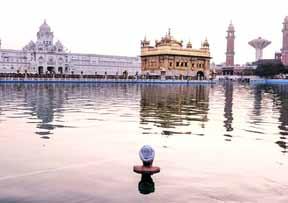









Trudi Busch, Director of Marketing, Sponsorship and Community at HomeWorld loves her job. So much so, that she often drives out to the various HW centres on the weekends and looks at the faces of the various people visiting the display homes in these locations.
“The very look of delight and happiness when they discover their perfect home is what makes my job seems worthwhile,” she says excitedly. “All the challenges of the normal day to day grind pales into insignificance as I see people discover their dream house amongst the various display homes we have.”
The concept of a centre where builders could show case their offerings to prospective buyers via HomeWorld display villages started in 1986.
This concept of a one-stop shop for anyone wanting to construct their own homes using quality builders has grown from strength to strength. HomeWorld’s latest offering at Box Hill has more than 113 houses on display from 33 builders, said to be one of the biggest in the southern hemisphere. Rather than just visualise your dream home, here you can almost see your family in the new home - and visualise where your favourite lehenga will hang, or where that ancient Sumeet grinder will be stored.
The HomeWorld Box Hill display village adds on to the centres at Marsden Park, Leppington, Thornton and Warnervale.
It has builders such as Eden Brae who have large family homes in different

designs, Masterton Homes who have on display small homes for first home buyers and those with smaller blocks of land, Rawson homes with double story options, Montgomery Homes who have perfect designs for sloping blocks, and Meridian Homes who have on display their external granny flat offering and also duplexes. For those wanting more options on granny flats, Wisdom Homes has a few options.
These homes by established builders factor in all the current trends that the consumer is looking for. The kitchen area for example, has become the hub for the family to chill in, and is also perfect for those intimate gatherings with close circle friends. The new solution for this is to have an open cooking area AND a closed kitchen area behind the new kitchen. (Handy hint for Indian clients: this butler’s pantry option with two cooking
areas can be handy for your vegetarian and non-vegetarian cooking options).
Another attractive feature in many new properties is to have a barbecue area with an in-built cooking range. Perfect for that tandoori chicken to be searing away while that paneer tikka cooks on the side!
No Indian home in Australia is complete without a spot dedicated to the Gods - of Bollywood. Check out the designs on offer at HomeWorld Box Hill with an option for inhouse games/theatre room.
As one walks through the display village, one can only be limited by one’s imagination (oh, and budget too) about the type of property and features wanted in the new home. The builders and consultants on site are available to answer any questions and add to any ideas you may have for your perfect dream home.
Go on, take a drive out to HomeWorld display village sites in Box Hill, Marsden Park, Leppington, Thornton and Warnervale, and get an idea of all the options and inspirations for your dream home. There are over 113 designs here, installed by no less than 33 builders.



And if you see an excited Director of Marketing for HomeWorld walking around, stop and say hi.
HomeWorld display villages are open 10.00 am to 5.00 pm. No appointments are necessary.
More details on www.homeworld.com.au
Harley Medcalf, manager of cricket great Steve Waugh, on his campaign to help a select group of cricketers in India

 BY MANAN LUTHRA
BY MANAN LUTHRA
Harley Medcalf is describing a game of cricket he saw in India recently.
“I absolutely loved every minute of it,” he says enthusiastically. “You watch a guy running up to bowl, then realise one of his trouser legs is empty and flapping in the wind. Mid-delivery, he then pivots with a huge pole you would normally associate with bushwalking to seam the ball up. The batsman facing the ball only has one and a half arms but plays the most beautifully stylised cover drive with perfect balance. I was completely blown away.”
So blown away, in fact, that the physically challenged Indian cricketers he watched have now become a near obsession: he wants to raise $10,000 to help a hundred of them through the COVID-19 pandemic.

Summarising the career and character of Harley Medcalf in a few words is challenging. The Managing Director of Duet Entertainment and Sport, which produces and promotes stage plays and concert events around the world, he has been a key figure in entertainment since the 1970s. Working with the likes of Elton John, Queen and the ABC, he also acts as the manager of numerous Australian sporting personalities, including former Australian captain and cricket great, Steve Waugh.
Harley also raises funds for children with rare diseases, tertiary education in developing countries, and the Veterinary Science Foundation.
In January, Harley and Steve Waugh met the players during their trip around India to photograph them for Steve’s soonto-be-released book The Spirit of Cricket Now Harley’s combining his passion for entertainment with his sporting partnerships and desire to give back, into this one special project. With, of course, some assistance from his sizable following, and Steve Waugh.
“Things were starting to go quickly downhill with COVID-19…I thought I could do something,” he tells Indian Link.
The players’ traditional funding from sponsors has gone to the PM CARES Fund, leaving them ‘struggling for food and
medicine’.
Working with the Physically Challenged Cricketers Association of India to raise these funds, Harley’s GoGetFunding campaign has already raised A$5,000. It’s partly thanks to some online promotion by Steve Waugh – but he doesn’t plan to stop there.
“I’ve got donations from $30 to $1,000,” he reveals. “Of course, helping 100 players is only the first target. Based on the response, I feel the need to help them long-term as well, possibly through corporate support. It is generating a lot of interest in India and the current players of the senior men’s team.”
Of all the interest, however, what appears to be motivating him is the drive these players have for the game.
“They play an immensely competitive game, committing 100% to it,” Harley says,

obviously in awe. “They don’t see [their disability] as a hindrance to their cricket or to their life. They’re just really passionate about the game, passionate about their team, their colours. For me these are old-fashioned qualities I find inspirational. It’s hard to find them today in many places.”
The players have been described not as ‘physically challenged, but enabled’ by Steve Waugh.
Indeed, in a tour that featured meet-andgreets with both old and young cricketers –Harley spoke fondly of Steve inviting Sachin Tendulkar to present a cake to the then-active first-class cricketer Vasant Ranji on his 100th birthday, as well as witnessing cricket played in Mumbai and Kolkata’s famous maidans –both Steve and Harley consider meeting the cricketers with disabilities as a truly special moment.
“Watching them was a real privilege,” Steve Waugh describes. “They had the hang time of a Michael Jordan, the flexibility of a ballerina, and the athleticism of an Olympic athlete.”
After coaxing a prediction out of Harley for the 2020-21 Australia-India Test series (“I think Australia will struggle to beat India this time…but when they get out in the middle, both teams will be at it 100 per cent”), he ends the interview simply but eloquently.
“100 per cent of the fundraising from my campaign goes to the players, and anyone can donate. Everything helps.”
To donate, please visit https://gogetfunding.com/physicallychallenged-cricket-association-of-india/

















How did you keep the kids occupied over the locked down school holidays?
The Reddy family of Strathfield NSW got their kids involved in hosting a food drive.
In a weeklong activity that kept them totally engrossed, Neil Reddy (12) and his brother Nikhil (11) collected 168kg worth of donations for Foodbank Australia.


The donated items came from families in their neighbourhood, and were delivered by the Reddy family to Foodbank’s warehouse in Glendenning.
“Nearly 40 families helped us in our food drive,” Neil Reddy, a Year 7 student of Sydney Tech High School, told Indian Link. “They responded to our letterbox drop-offs in which we asked for items like canned food, pasta, biscuits, water, pet food and toiletries.”
The boys printed off 400 flyers at home about Foodcamp, asking for the donations to be dropped off at their home.
Bags filled with food began to arrive shortly thereafter, the wet weather notwithstanding.
“We kept a table outside with signs,”Neil
described.
Nikhil, his younger brother, said, “My favourite part was when people knocked on the door.”
Mum Sandhya laughed as she recalled the boys’ second favourite activity – arranging the cans of food into giant pyramids.

At the end of the week, the boys sorted the items into bags, and drove out with Mum and Dad to hand in their collected items.
“I felt good and proud,” Nikhil, a Year 6 student at Strathfield South Public School, reported. “I’m happy that people in need could have the food they need.”
“We didn’t get a chance to thank all the people that donated, as many of them dropped off at our doorstep,” Dad Karri Reddy told Indian Link. “Perhaps we can say thank you through this article!”
Sandhya and Karri Reddy are keen to inculcate a spirit of volunteering and good citizenship in their children.
“We like the idea of Foodbank, especially in these times of COVID,” Sandhya observed. “Unfortunately, you have to be at least 15 years old to volunteer with them. So they advised our kids to do a food drive instead.”
She added, “Foodbank said they would pick the donations up from our home, but we thought it might be a better experience for the boys to actually see how the food is collected at the warehouse in Glendenning. It gave them a sense of how others are giving freely to those that need.”
Neil has already had an experience of volunteering when he participated in Chinmaya Mission’s No Shoes campaign this year, a barefoot walk in aid of Multiple Sclerosis awareness.
Both brothers also paid an Anzac tribute this year on 25 April – they played The Last Post at dawn on their driveway as neighbours dropped by to listen and share an early snack of Anzac biscuits.
The Reddys, both SES volunteers themselves, feel that it’s important for children of New Australians to become part of the community where they are growing up. “We teach our kids two important lessons: be happy, and be good citizens. The first is for their own good; the second, for the good of the community in which they live.”
The Reddys might be on to somethingresearch reveals that there are many social and psychological benefits to volunteering. It bolsters a sense of community and improves self-esteem and confidence, but perhaps more significantly, it keeps social isolation and depression at bay, and can alleviate anxiety.





 BY MOHAN DHALL
BY MOHAN DHALL
She said, “I have lost two friends… I was really close to one of them… but the teachers told us to focus as we have the Trial HSC exams soon.”
He said, “I lost my best friend this morning – I can’t have our study session today.” He then added too quickly, “I…I am…alright. I am…fine.”
In both situations I told these students that they should have grief counselling. However, even weeks after these events their schools did not offer any grief counselling or support for these students to cope with the impact of their loss. It is as though compartmentalisation is the new invincible. As if rationality is the new best friend. But it isn’t and never was.
We live in a time where “social distancing” is a reality and a metaphor. We can change the wording to “physical” distancing, but it does not change the isolation students and adults feel. Many are lost and wanting to be noticed. Distancing, premised on distrust, makes us ache to be
known, to be heard, to feel safe. Estranged children are dying at their own hands.
Every year, I ask university students and educators this question. Which is the single incident they remember most strongly - like it happened a moment ago?
Occasionally, a student says that a teacher spoke a line of encouragement which made them believe in themselves for the first time. This is powerful and life changing.
However, mostly the memories are of being bullied, being misunderstood, feeling afraid, isolated, put down or lost.
Years later students tremble as if, in recollection, that single moment is right there in the present.
Twelve years ago, an international student said his single strongest memory was the day he came to school and the seat beside him was empty. That student never came back, and no-one spoke about his passing. A week later the seat was filled by a new student, like the water closing behind a boat. He said that memory is as vivid for him as the day it had occurred and he still cannot shake the memory of the chair being filled, ‘erasing’ the loss.
Another student years later said that
he was in a car with his best mates on the evening before his school graduation when the teenage driver crashed the car, killing three of his friends. The teachers and school specifically told him to be strong. While speaking about this, his voice grew softer. He said, “This is the first time I have spoken about this. Not being able to tell anyone by being ‘strong’, ruined my life. It ruined my marriage and has estranged me from my sons.”
If a child is distracted by the pain they feel, they will not be learning whatever subject is being taught. They will be role playing being present while feeling miles behind their eyes. In order for teachers to make an impact, every word they express must be attended to. Every implication in every sentence. Every ‘throwaway’ line. Attending takes time, but everyone seems time poor. There’s a rush to go home.
It would be good if educational systems were aligned to reality: the real world of broken pieces needing mending, of broken hearts needing healing, of embracing vulnerability and understanding that without emotional management, we cripple learning.

This year, exams do not really matter. This year universities should let students know their faculties will always be open. Leaders should be making it clear that everything will be alright. They may not have the answers, but they can make it explicit that we will find a way.
The statistics say that as of 10 Aug, over three hundred Australians have died from coronavirus. My direct experience however is that the number is much higher. There is increased incidence of domestic violence, and increased youth suicide - so many more have died than those unable to breathe. There are many who die numb from being unheard and unnoticed.
The real trial examination is on the schools and the system. What is worth more – six exams or many lives? Are schools and the system too focused on ticking boxes and getting things done, or can we pause and shape the curriculum around the reality of the times?
Can we do this, even if it means slowing down to allow tears, while recognising that vulnerability is a strength and the basis of our common humanity?
During the formative stages of the COVID-19 pandemic taking hold across the country in March, Cricket Australia itself acknowledged that it had been extremely lucky. While winter sports like the NRL and AFL were fighting tooth and nail to commence their leagues and simply remain solvent, CA had just managed to host one of the most successful women’s sporting events in history in the T20 World Cup, culminating in a grand final won by the home team in front of nearly 90,000 fans. CA also had a sixmonth buffer to play with before it was due to host the T20 World Cup for the first time.
But as the year has unfolded, CA has now started feeling the pandemic’s pinch. The T20 World Cup has now been cancelled, driving a $20 million hit to CA’s bottom line. Despite CA expressing in a leaked email its strong preference to postpone the tournament to 2021, citing confidence it would be able to hold the tournament by then, the ICC has instead bowed to pressure from the BCCI to keep the 2021 T20 World Cup in India, leaving Australia to host the 2022 tournament – meaning CA’s share of tournament revenue will hit two years later than originally scheduled.
It’s a significant blow to CA, who have already been grappling since April with significant cash flow issues that saw it stand down roughly 80% of its workforce on only 20% pay, ultimately resulting in 40 job cuts amidst a broader $40 million swathe of budget cuts. Citing confidence Australia would be able to safely host the tournament by late 2021, CA’s board was hoping for only a 12-month delay in the tournament, helping to
mitigate the impact of a delay on CA’s cash flow and also avoid a necessary dismantling of the local organising committee originally created for the 2020 event.
The ICC instead chose in favour of the BCCI hosting the 2021 tournament, but gave no substantive reasons as to its decision. ESPN Cricinfo reported that CA was unable to commit the confidence of the Australian government to host the tournament in 2021, a claim that CA’s interim CEO Nick Hockley has since denied, citing that the government would have supported either a 2021 or 2022 tournament.

The ICC’s decision came as Australia
grappled with a second wave of infections in Victoria that has tarnished Australia’s image as a largely COVID-safe region, yet India’s case numbers dwarf that of any other cricketing nation. At the time of the ICC’s announcement regarding the 2021 and 2022 tournaments, India’s case count had surged past 2 million, compared with Australia’s 20,000. Population disparity aside, India’s struggle to contain the pandemic shows no sign of abating across the subcontinent, while states such as South Australia, Queensland and Western Australia are relatively COVID-free. These numbers reflect why there’s a quiet
consensus that it would have made more sense for Australia to host the 2021 edition, given the greater certainty that it would be able to safely and successfully hold a global tournament within the next 12 months. This is critical; nations outside the “Big Three” of India, England and Australia are heavily reliant on their share of revenues from ICC tournaments, and any cancellation due to a foreseeable COVID risk would be potentially catastrophic for the poorer boards.
There’s also the curious fate of the next Women’s ODI World Cup, which was scheduled to be held in New Zealand in February 2021 but was also postponed by the ICC. New Zealand Sports Minister Grant Robertson stated New Zealand “could have done it in 2021”, and labelled the ICC’s decision “disappointing” for women’s cricket.
Ironically, there’s a chance CA might actually stand to gain from the two-year delay, but it would be by happy accident rather than by design. Broadcasting revenue from ICC events is shared amongst participating countries, but ticket revenue, including lucrative hospitality packages, is largely retained by the host country.
While crowds would not have been permitted were the tournament to be held next month, and there’s no guarantee that they would have been permitted at cricket matches in 2021, 2022 appears a safer bet for that revenue stream. Still, CA would have jumped at the opportunity to secure its share of the ICC event revenue in 2021, and a more fairly balanced global governing body may have overseen a different outcome. CA now awaits India’s arrival in December, a vital tour that takes on even greater significance.
The ICC’s opaque approach to navigating the impacts of COVID-19 on its members may merely raise eyebrows for now; but expect fireworks beyond those in the IPL if the ICC’s high-stakes gamble on India proves unsuccessful.




At the time of the ICC’s announcement regarding the 2021 and 2022 tournaments, India’s case count had surged past 2 million, compared with Australia’s 20,000.CA interim CEO Nick Hockley is now in critical discussions with the BCCI and the Australian government to ensure India's tour of Australia proceeds as planned.


What do you do when you have a robust event management business where you can organise functions for 50 people to 2,000; are accredited to the best hotels and venues as the preferred supplier; have your own restaurant in the glitzy end of town at King Street Wharf where celebrities like legendary Australian cricketer Steve Waugh and broadcaster Alan Jones host friends, family and colleagues; a function centre at Concord which hosts gala events; two longstanding restaurants in trendy Balmain and suburban Wollongong where the locals line up for their curry nights, and frequently front up to the media such as in the SBS docuseries Turban Legends?
Suffice it to say, your plate is pretty full. And then COVID-19 strikes, and there’s a paradigm shift.
The State government brings in new restrictions on gatherings and the number of people that can now attend parties, social distancing measures come into effect, and the whole mindset of the public is to bunker down in their personal space rather than to venture out. The city of Sydney grinds to a halt and hospitality venues feel the full force of COVID-19.
Speaking to Indian Link, Deep Gujral, Managing Director of wellknown restaurant Manjit’s, said with steely resolve, “We faced this situation full frontal in March this year when bookings got cancelled and functions were indefinitely postponed. The whole business model came to a standstill. But, as they say, when the going gets tough, the tough get going.”
He explains, “My father Manjit and mother Kanwal have over 70 years of joint experience in the hospitality industry in Australia. In fact, as a team, we doubt if anyone has more experience than them in the Indian food scene here. They have been through various economic changes which flow on to the food industry. Together with my brother Varun who runs the King Street Wharf restaurant, which has been awarded Two Hats by the Australian Good Food Guide in 2019 and 2020, we sat down and came up with a plan to work through the challenges of COVID 19.” The plan involves getting out to the clients who cannot come in to Manjit’s.
Beautiful, 34-year-old girl, highly educated, very good family background, soft spoken, career oriented, vegetarian Brahmin, working and well settled in Sydney, seeks an educated match, teetotaller with good family background. Prefer Australian citizen or PR.
Please contact rajsyd83@gmail.com
Seeking bridegroom for Australian citizen, Hindu Brahmin girl ’91-born, height 5'2", Masters in Clinical Psychology, working full time in Govt Hospital. Please contact Preeti Kothari 04 04 316 288.

“We cook great food which is appreciated by all, we have a great brand name in Manjit’s. So if people cannot come in to us due to COVID 19, we can take our food out to them. And so we launched Manjit’s Home. We will produce and distribute heat-and-eat home range of curries and make sure these food packs are available far and wide,” Deep said.
Much R&D went into Manjit’s Home curries. Being a heat-and-eat option, it was necessary to ensure the ingredients in the preparations keep their taste and flavour for their duration.
“It was important to us to keep our authenticity and also what we pride ourselves in – the quality of food we serve. Food scientists and food consultants were brought in to help us create nine options for our consumers in the Manjit Home product range. From the ever popular Butter Chicken and Rice, to Palak Paneer and Rice, there is food to suit every palate,” Deep said.
The purists at Manjit are aware that heat-and-eat packaged meals don’talways have the best reputation. “Yes, there is a stigma of them being cheap, easy, low quality and sometimes even nasty,” Deep admits. “These are attributes that were once shared by some for Indian cuisine in general. Manjit’s changed the game and have raised the profile of Indian cuisine over the past four decades. While our new products can still be something that you pick up from your local on the way home from work, we’re on a mission to reinvent the concept, delivering something fresh, hand-made and packaged, with the care and attention to quality the surpasses the alternatives on the shelf. Manjit’s has always offered ‘something different’, and that isn’t stopping now!”
The opportunities have been exciting, Deep reveals. “What has been a strong learning curve is the logistical exercise of distribution. We’ve been blown away by the demand, which has come from in far and wide - IGA outlets to service stations, Indian grocery stores to the Australian Navy. Interestingly, we have had a few gyms approach us to explore options of proteinbased packs such as a chicken tikka pack - with all the flavours and no carbs.”
Contact Manjit’s Home on 02 9062 3000 or email home@manjits.com.au
Indian Christian Protestant parents seek a suitable match for their 40-year-old son, a software engineer, born and brought up in Australia. Seeking a Protestant girl between 32-37 years.
Email: sammy5073@gmail.com, Mob 04 03 836 360.
Seeking match for 35-year-old, 6' tall, Tamil Hindu Brahmin, IT professional, working for a top organisation in Sydney. Possess PR Visa. Girl should be Hindu vegetarian, preferably citizen/PR. Please send pro le to aravind7778@gmail.com
Seeking match for educated, divorced, 5’9'', 1975 born Sikh boy, selfemployed on bridging visa with full work rights. Looking for PR/citizen girl from Australia. Phone: 0422 812 939 or email: jas_ghai01@hotmail.com












Like birds from the woods, they flocked together
So the hawk could have his fill, my friends. To quench Dyer’s deadly thirst With streams of blood their own, my friends. Ah! My city mourns with grief today
Happy homes lie shattered because they go. Heads held high offered for sacrifice For Bharat Mata’s pride and honour, they go. Pray, stop these valiant souls of God! Straight to the abyss, they rise and go.
O mothers, watch your precious sons
To give up their youthful lives, they go. O sisters, hold back your brothers dear You won’t see them again once they go.
O wives, hang on to your dear beloveds Or you’ll spend your lives widowed, if they go.
O children, go run and hug your fathers
’Cause you’ll be orphans if they go. Stop them, hold them, do what you can They won’t come back, once they go. Says Nanak Singh, Can’t stop them now For nation’s sake to die they go.

Five-thirty sharp the clock had struck Thousands gathered in the Bagh, my friends. Leaders came to lament the nation’s woes Taking turns to speak out loud, my friends. Voiced grievance, hardship, anger, sorrow Saying, no one listens to us, my friends. What can we do, what options left?
Can’t see any ray of light, my friends. Those words forlorn, they barely voiced Came soldiers thundering down, my friends.
At Dyer’s command, those Gurkha troops Gathered in a formation tight, my friends. Under the tyrant’s orders, they opened fire Straight into innocent hearts, my friends. And fire and fire and fire they did Some thousands of bullets were shot, my friends.
Like searing hail they felled our youth A tempest not seen before, my friends. Riddled chests and bodies slid to the ground Each one a target large, my friends. Haunting cries for help did rend the sky Smoke rose from smouldering guns, my friends.
Just a sip of water was all they sought Valiant youth lay dying in the dust, my friends.
That narrow lane to enter the Bagh Sealed off on Dyer’s command, my friends. No exit, no escape, no way out was left Making the Bagh a deathly trap, my friends. A fortunate few somehow survived While most died then and there, my friends. Some ran with bullets ripping their chest Stumbling to their painful end, my friends. Others caught the bullet while running away Dropping lifeless in awkward heaps, my friends.
In minutes, the Bagh so strewn with corpses None knew just who was who, my friends. Many of them did look like Sikhs Amid Hindus and Muslims plenty, my friends.
In the prime of their youth, our bravehearts lay Gasping for one last breath, my friends. Long hair lay matted in blood and grime In slumber deep they sleep, my friends. Says Nanak Singh, Who knows their state But God the One and Only, my friends.

Poonam was the main one in her family in whom her mother confided. The stories started when Poonam was just a child; she thinks she was younger than her daughter is now. Most parents read books to their children before they sleep. Nirmal’s bedtime tales were of growing up in Lahore, the journey she made to India and the experience of being a refugee. She was not always judicious in the amount of detail she shared. Early on in her life, Poonam had a
sense that something terrible had happened to her mother.
In the retelling of Nirmal’s experiences, it was as if she were reliving it all again. ‘It was part of our daily lives… It was the formative experience of her life and in a strange way it became the formative experience of my life because she spoke about it all the time.’
Poonam does not think of it on a day-to-day basis now, but says partition defined her because it so utterly defined her mother, and shaped who she became. ‘Partition is always

there in the background.’
In the last years of her life, Nirmal lived in this family home, cared for by her daughter. Photos of her with her beloved grandchildren are on prominent display in the kitchen. Nirmal, or Nimmi as she was known, began her life on the outskirts of Lahore, born into a middle-class family in 1929. She spoke of her pets: the rabbits and dogs. Her family were Hindu, belonging to the Arya Samaj sect, which rejects idol worship and promotes equality of women.


traders appointed by Robert Clive – the new governor of Bengal – and the directors of the Company, whom the document describes as ‘the high and mighty, the noblest of exalted nobles, the chief of illustrious warriors, our faithful servants and sincere well-wishers, worthy of our royal favours, the English Company’. The collecting of Mughal taxes was henceforth subcontracted to a powerful multinational corporation – whose revenuecollecting operations were protected by its own private army.
One of the very first Indian words to enter the English language was the Hindustani slang for plunder: loot. According to the Oxford English Dictionary, this word was rarely heard outside the plains of north India until the late eighteenth century, when it suddenly became a common term across Britain.
To understand how and why it took root and flourished in so distant a landscape, one need only visit Powis Castle in the Welsh Marches. The last hereditary Welsh prince, the memorably named Owain Gruffydd ap Gwenwynwyn, built Powis Castle as a craggy fort in the thirteenth century; the estate was his reward for abandoning Wales to the rule of the English monarchy. But its most spectacular treasures date from a much later period of English conquest and appropriation. For Powis is simply awash with loot from India, room after room of imperial plunder, extracted by the East India Company (EIC) in the eighteenth century. There are more Mughal artefacts stacked in this private house in the Welsh countryside than are on display in any one place in India – even the National Museum in Delhi. The riches include hookahs of burnished gold inlaid with empurpled ebony; superbly inscribed Badakhshan spinels and jewelled daggers; gleaming rubies the colour of pigeon’s blood, and
scatterings of lizard-green emeralds.
There are tigers’ heads set with sapphires and yellow topaz; ornaments of jade and ivory; silken hangings embroidered with poppies and lotuses; statues of Hindu gods and coats of elephant armour. In pride of place stand two great war trophies taken after their owners had been defeated and killed: the palanquin Siraj ud-Daula, the Nawab of Bengal, left behind when he fled the battlefield of Plassey, and the campaign tent of Tipu Sultan, the Tiger of Mysore.
Such is the dazzle of these treasures that, as a visitor last summer, I nearly missed the huge framed canvas that explains how all this loot came to be here. The picture hangs in the shadows over a doorway in a wooden chamber at the top of a dark, oak-panelled staircase. It is not a masterpiece, but it
does repay close study. An effete Indian prince, wearing cloth of gold, sits high on his throne under a silken canopy. On his left stand scimitar- and spear-carrying officers from his own army; to his right, a group of powdered and periwigged Georgian gentlemen.
The prince is eagerly thrusting a scroll into the hands of a slightly overweight Englishman in a red frock coat. The painting shows a scene from August 1765, when the young Mughal emperor Shah Alam, exiled from Delhi and defeated by East India Company troops, was forced into what we would now call an act of ‘involuntary privatisation’.
The scroll is an order to dismiss his own Mughal revenue officials in Bengal, Bihar and Orissa, and replace them with a set of English
Theirs was a home full of music and singing. A twenty-year age gap existed between Nirmal’s parents. Her mother was married at the age of twelve, but was fortunate that her in-laws encouraged her ambitions to study. It was an unusual household, with Nirmal’s mother assuming the patriarchal role. She qualified as a teacher, and worked while her husband looked after Nirmal and her sisters.
Nirmal adored her father, who in turn doted on her. Like so many of her generation, she told Poonam of how she

celebrated festivals with other neighbours, irrespective of religion, though when she was much younger at school she recalled an incident of a Muslim man knifing a Hindu bookbinder, which resulted in shops being closed in their area and panic spreading. Because of this, Nirmal was taken out of the Urdu section of her school and placed in the Hindi part. From time to time incidents like this did occur in her child – Nirmal pointed out – amongst both Hindu and Muslim fanatics.
Nirmal observed that hopes for independence from British rule were at first about desh prem, love of your homeland. But it soon became about love of your religion. The first inkling of this came when Ashraf, a Muslim classmate seated at her desk, punched the air with her fist saying: ‘We’re going to get rid of all of you… Lahore will be in Pakistan.’ Nirmal dismissed it, and thought it a strange comment from the girl, but Poonam identifies this as a significant moment.
The Company had been authorised by its founding charter to ‘wage war’, and had been using violence to gain its ends since it boarded and captured a Portuguese vessel on its maiden voyage in 1602. Moreover, it had controlled small areas around its Indian settlements since the 1630s. Nevertheless, 1765 was really the moment that the East India Company ceased to be anything even distantly resembling a conventional trading corporation — dealing in silks and spices — and became something altogether much more unusual.
Within a few months, 250 company clerks, backed by the military force of 20,000 locally recruited Indian soldiers, had become the effective rulers of the richest Mughal provinces. An international corporation was in the process of transforming itself into an aggressive colonial power.
By 1803, when its private army had grown to nearly 200,000 men, it had swiftly subdued or directly seized an entire subcontinent. Astonishingly, this took less than half a century. The first serious territorial conquests began in Bengal in 1756; forty-seven years later, the Company’s reach extended as far north as the Mughal capital of Delhi, and almost all of India, south of that city, was by then effectively ruled from a boardroom in the City of London. ‘What honour is left to us,’ asked a Mughal official, ‘when we have to take orders from a handful of traders who have not yet learned to washtheir bottoms?’
Chatpati chutneys – how much more enjoyable they make our meals! The ever popular pudina (mint) chutney and imli (tamarind) chutney may continue to grace our tables for years to come, but every so often you come across a more exotic variant. Ever tried an eggplant or a green apple chutney?

RADHIKA KULHALLI
■ 4 large fresh carrots
■ Green chillies to taste
■ Juice of 1 lemon
■ ½ bunch coriander
■ ¼ tsp roasted methi (fenugreek) seeds
■ ¼ tsp asafetida
■ ½ tsp mustard seeds
■ 1 tbsp oil
Grate carrots, chop chillies and fresh coriander. Grind it coarse in the grinder with the salt, lemon juice and methi seeds powder. Heat oil and add mustard seeds. When they begin to pop, add asafetida and pour on the ground chutney. Mix well and enjoy!


VANDANA LALL
■ 250 gms sweet potatoes
■ 2 green mangoes, small
■ Dry red chillies to taste
■ 1 tbsp urad dal
■ ¼ tsp cumin seeds
■ ¼ tsp mustard seeds
■ 1 sprig curry leaves
■ Salt to taste
Boil and peel sweet potatoes. Chop mangoes roughly. Roast dal till red and grind to a paste along with mangoes, red chillies and sweet potatoes. Then heat oil in a small pan and add curry leaves, mustard seeds (and additional red chillies if you like!). When the seeds begin to splutter, pour over the chutney.
RENU NANDA
■ 2 green apples
■ 1 onion
■ 3-4 green chillies or to taste
■ ¼ bunch coriander
■ 1 ½ tsp fresh grated ginger
■ Salt to taste
Peel and core apples; chop roughly. Combine with other ingredients and grind to a smooth paste.
The Indian chutney can take innumerable forms, we’ve found, thanks to the number of recipes that readers have sent us over the years. Here’s to celebrating the culinary diversity of India with some hatke twists on our beloved chutneys.GREEN A PP LE CHUTNE Y SWEET P OTATO CHUTNE Y CARROT CHUTNE Y
GLADYS ROACH
■ 1 ½ kg ripe tomatoes, chopped
■ 1 large beetroot, peeled and grated
■ 2 tsp chilli powder
■ ½ tsp cinnamon powder
■ ½ tsp clove powder
■ ½ kg brown sugar
■ 2 tbsp minced garlic
■ ½ cup brown vinegar
■ 1 tsp salt
■ 2 tbsp sultanas
■ 1 tbsp grated ginger
■ 1 tbsp vegetable oil
Mix the tomatoes and beetroot and their juice in a saucepan. Bring to a boil and simmer till mixture is pulped and beetroot is cooked. Rub the mixture through a sieve and discard any residue. Reheat the mixture on medium heat. Mix in all the other ingredients. Cook uncovered, stirring occasionally, until mixture thickens and is a jam like consistency. Cool and bottle.
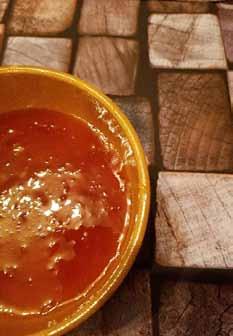

SHUBHRA GUPTA
■ 15 cloves garlic, peeled
■ 3 tomatoes
■ 3 red chillies
■ 1 inch piece ginger, chopped
■ 2 tbsp chopped coriander leaves
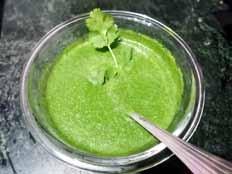
■ 1 tsp salt
■ 1 tsp red chilli powder
■ 3 tbsp oil
■ Pinch asafoetida
■ 1 tsp mustard seeds
■ Water if needed.
In a blender, blend tomatoes, garlic, whole red chillies, salt, red chilli powder and ginger. Heat oil in a pan and add asafoetida. Add mustard seeds and let them crackle. Add the blended puree and let it all boil well. Add water if necessary. Check the seasoning and adjust accordingly. Cool the chutney and serve with desired snacks.
RADHIKA KULHALLI
■ 1 raw mango, medium sized
■ 1 bunch fresh mint
■ 1 small onion
■ Red chilli powder to taste
■ ½ tsp roasted methi powder
■ 1 tbsp brown sugar
■ ½ tsp mustard seeds
■ ¼ tsp asafetida
■ 2 tbsp oil
Chop raw mango, mint and onion finely. Grind coarsely in the grinder with chilli powder, salt, methi seeds powder and brown sugar. Heat oil and add mustard seeds. When they begin to splutter, add asafetida and pour on the ground chutney. Mix well.
PRAMILLA CHATURVEDI
■ 100 gms dried apricots
■ 50 ml light vinegar
■ 75-100 gms raw sugar
■ 1 tbsp fresh grated ginger
■ 1 clove crushed garlic
■ Salt and chilli powder to taste
MADHAVI SRIDHAR
■ 6 cups chopped onions
■ ½ cup lemon juice
■ 2 tsp cumin seeds
■ 1 tsp mustard seeds
■ ½ tsp Tabasco sauce
■ Red chilli powder to taste
■ ¼ cup brown sugar
■ Salt to taste
Combine all ingredients in a large frying pan and cook over medium heat. Stir continuously till it all comes to a boil. take off heat immediately. Pour into hot sterilized jars.
SHUBHRA GUPTA
■ ½ tsp mustard seeds
■ ¼ tsp cumin seeds
■ 1 tbsp vegetable oil
■ ½ tsp garlic, minced
■ ½ tsp ginger, grated
■ 2 cups tomatoes, chopped
■ ½ tsp red chilli powder
■ 1/8 tsp turmeric
■ Salt to taste
■ 1 tsp lemon juice
GLADYS ROACH
■ 4 Tahitian limes
■ 1 ½ cups brown malt vinegar
■ 4 pears, peeled, seeded and chopped
■ 2 cups brown sugar
■ 250 gm dates, chopped
■ 2 tbsp ginger, grated
■ 10 red chillies, sliced
■ Salt to taste
In a covered frying pan, heat mustard and cumin seeds in oil over mediumhigh heat. When mustard seeds begin to pop, turn heat down to medium. Add garlic and ginger; stir for 30 seconds. Add tomato and simmer for 2-3 minutes. Add red pepper, turmeric, and salt and fry until tomatoes are well cooked and broken up. Stir frequently to prevent sticking. Add lemon juice and remove from heat.
Finely slice the limes, discard the seeds and cook in cup of vinegar till tender. Separately cook all the other ingredients till very thick. Half-way through the cooking, add the cooked limes and mix well. Stir constantly to prevent the chutney from sticking to the bottom of the pan. Cool and bottle.

VANDANA LALL
■ 1 large eggplant
■ Green chillies to taste
■ Dry red chillies to taste
■ 1 tsp urad dal
■ 1 lime-sized ball tamarind
■ ½ tsp jaggery
■ 1 tbsp oil
Soak apricots overnight in 100ml water (or 3-4 hours in hot water). Place the apricots and the soaking liquid with enough water to cover, in a saucepan. Simmer until tender, then beat or blend to a smooth consistency. In a separate saucepan, place the vinegar, sugar, ginger, garlic, chilli powder and salt. Heat gently, stirring until the sugar has dissolved, then increase the heat until a syrup is formed. Stir the apricot paste into the sugar and simmer gently for about ten minutes to desired thickness. Allow to cool and bottle in airtight jars with vinegar-proof tops.
■ Salt to taste.
Grill eggplant till skin wrinkles and turns black. Toss into cold water, cool and peel. Heat oil and fry red chilli and dal till red. Remove and grind to a fine paste along with all the other ingredients.
S TA RRIN G: Naseeruddin Shah, Atul Kulkarni, Shreya Chaudhary
D I R EC TOR: Anand Tiwari
HHH
Scenic Rajasthan, some fabulous acting and lots of great music could be reasons to watch Bandish Bandits, an otherwise average musical propped by the theory that opposites attract in love. In an early scene, protagonist Radhe, played by budding actor Ritwik Bhowmik, strains to hit the right high note of a complex raaga. As the episodes roll, you realise the series itself is much like Radhe in that scene, struggling to hit the right high point.
S TA RRIN G: Nawazuddin Siddiqui, Radhika Apte, Shweta Tripathi
D I R EC TOR: Honey Trehan
HHHH
Raat Akeli Hai, Nawazuddin Siddiqui’s new starrer, departs from stock gimmick quota that often de nes the Bollywood thriller. In this lm, an oldworld suspense drama is served up for a contemporary audience.

Whodunits never fail to fascinate, more so if they come packaged with an enticing noir edge - a story that can stimulate and entertain at the same time.
Raat Akeli Hai falls back on such a formula to regale, a rarity in Hindi mainstream.
The core would seem familiar. A murder takes place in an af uent home. Each of the members of the dysfunctional household could be a suspect. In classic whodunit template, the story moves to its climax in such
head over heels.
She suggests a collaboration with Radhe, convinced that a fusion of her pop rhythm and his classical melody is the secret formula that will give her the big hit she needs. He is reluctant initially, wary that the move will upset his purist grandfather, but then hits upon a wonky idea.
There are the occasional efforts to stir up drama as Radhe and Tamanna’s story plods along, but these are as half-baked as the overall storytelling. With every passing episode, the series begins to lose its draw.
Like most coming-of-age stories, Bandish Bandits follows a pattern. It lays out a predictable storyline with hardly any dramatic high worth recall, even after 10 episodes 40 to 60 minutes each.

Bandish Bandits talks of con ict and con uence points that the worlds of Indian classical and western pop music share. It works at establishing how there still are enough people around for whom the purity of art triumphs over the trappings of fame and riches.
Creator Anand Tiwari and his team of co-writers (Adhir Bhat, Amritpal Singh Bindra, Lara Chandni) set the mood and motive of the story in the rst episode. Early in the Jodhpur
dawn, Pandit Radhemohan Rathod (Naseeruddin Shah), Sangeet Samrat, trains with his disciples. Among them is his grandson Radhe.
Far removed from Radhe’s world is Tamanna (Shreya Chaudhary). She is a city-bred, internet sensation pop who dreams to sing with her idol, international music star Queen Eli. For that to happen, she desperately needs to deliver a de ning hit. Time is running out for her to score her elusive blockbuster.
Travelling to Jodhpur, she has checked into the hotel where Radhe works as a part-time waiter. Tamanna and Radhe’s paths cross and, after a cliched rst-encounter rift, she falls
Essentially, two things salvage the show. The rst is Shankar-EhsaanLoy’s music, produced by Dawgeek. When a soundtrack boasts popular stars as Armaan Malik, Jonita Gandhi, Javed Ali and Shankar Mahadevan, along with the inimitable Mame Khan and the maestro Pandit Ajoy Chakraborty, it is a rare treat. In fact, there are portions where the narrative drags, and you sit up as a few snatches of gaayaki take over. Music becomes a parallel protagonist to Pandit Rathod, Radhe and Tamannah. The other aspect worth mentioning is the acting. Greenhorn Ritwik Bhowmik puts on an effectively understated act as Radhe, a foil of sorts to the effervescent Tamanna. Shreya Chaudhary as Tamannah tends to go hyper in parts, but that suits her livewire pop star avatar.
There is very little that one can add to describe a Naseeruddin Shah performance after all these years. You could ll a book detailing the nuances with which he brings alive his role. Or, you could just sit back and relish, and watch the thespian go.
Vinayak ChakravortyThe mood for mystery is set right at the outset, in the opening shot. A truck follows a car down a pitch-dark highway and rams it off the road. The car turns turtle but its two passengers survive –only momentarily, for the truck driver will presently alight, and nish the formality of eliminating his victims.
moves ahead, there are twists galore to keep you guessing right till the end.
a way that when the truth is revealed, you’re in for a surprise.
Thematically, debutant director Honey Trehan’s lm could remind you of last year’s Daniel Craig-starrer Knives Out, though this lm narrates a very different storyline. The crusty small-town milieu here is another reason this lm manages to deliver with a slice of originality.
Fast forward ve years later, on the night of wedding to his much-younger mistress Radha (Radhika Apte), the aged patriarch (Khalid Tyabji) of a rich and power-wielding household is found dead on his nuptial bed. The family members immediately accuse the young Radha. But when the investigating cop Jatil Yadav (Nawazuddin Siddiqui) arrives, he realises this is no open and shut case. Things are far more complicated. Jatil understands almost every member in the household could have a motive to kill the old man. As the story
Smita Singh’s writing rolls in dark secrets, forbidden passions, unsavoury truths, haunting suspense and just the adequate amount of violence to set up an interesting narrative. Sure there are the convoluted edges, but clever storytelling manages to retain your interest.
Nawazuddin Siddiqui and Radhika Apte manage to share some brief, crackling chemistry in a couple of scenes, although this is far from a love story. Individually, both these phenomenal actors deliver the quality of performance you would expect from them.
Raat Akeli Hai is one of the better offerings from Net ix lately. That should matter a lot, considering rival OTT platforms have been revving up the entertainment quotient over the lockdown months.
Vinayak Chakravorty


Minal Khona has been reading tarot cards for the last two decades. She uses her intuition and connect with the cards mostly to help people.

You look for nancial security, which is not such a bad thing given the current scenario. If distance or other factors are coming in the way of a relationship, they can be overcome if both partners want to be together. A new business turns pro table though, if you are an employee, you might have to grin and bear it for a while. Have your health check-up done so that a recurring condition doesn’t get worse. You could inherit some money.



May 21 - June 20
The wheel of fortune is a number one which indicates change. If your life has been going downhill, expect things to improve. Avoid resisting whatever comes your way as it is a destiny card. An ex may return but you are not sure you want them back. Make changes at work if you want more job satisfaction. A friend could end up in the hospital. A situation that has been bothersome for a while will soon change for the better.
Don’t believe everything you see; there could be underhand deception – in your work or love life. Trust your instincts if you feel a sense of fear. A trip can turn out to be problematic, so try to postpone travel plans if possible. Con icts at work are frustrating but your self-control will save the day. In a relationship, watch out as your partner could be unfaithful. Don’t ignore any lumps in your body. Old con icts and grudges will zzle out.
L EO
July 21 - Aug 22
The usual ery, impetuous Leos show a more balanced Libran temperament this month as that is the card in uencing this month. You are faced with inner and outer con icts and worries about the future. If you have just broken up, let go of the past. For any obstacle, use your mind, as new ideas will see you through. If not you, someone in your family could be unwell and needs attention. Money is comfortable but there is some underlying stress.



Nov 22 - Dec 21
The best card in the pack is a mixed bag. The impact of the virus that has rattled the world will be felt in your life too. You feel the need to break free, so start with your mind. In your love life, let things be; a new start is round the corner. Money could be blocked; you could even lose your job. But if money is due to come, you could get it from more than one source.
V








Aug 23 - Sep 22
A person with a Scorpio temperament could in uence your behaviour this month. You want to focus on books, the metaphysical and meaningful work. You could meet the partner of your dreams at an event or right near you. There could be discord at home or work. Keep calm and don’t get into other people’s dramas; avoid playing martyr. There could be bouts of depression or emotional strain. An epiphany will give you the answer you seek.






Dec 22 - Jan 19
There could be delays or setbacks and you are seeking a change. Being cooped up during the lockdown has worn your nerves out. You want a deeper relationship and anything super cial doesn’t work for you anymore. You could receive some bad news about a loved one. Money concerns are real so spend carefully. Watch your diet and take rest so you don’t feel run down. Wait for guidance from the universe. Success comes through your innovating abilities.
Sep 23 - Oct 22
There could be losses in business, and even emotional strife due to other problems. It’s not an easy month where even expenses are high. A problem in your love life nds a solution in an unexpected manner or through someone. Stress gives you aches and pains. A new acquaintance or friendship could change your life’s direction. Don’t lose heart as a positive change is coming. Stay calm in the face of all upheavals as the outcome will be positive.
Jan 20 - Feb 18
There could be tension or stress due to current circumstances. You seek a new lifestyle; someone much younger might be trying to woo you. People at work and at home are supportive. You will make changes in your situation as you feel trapped and there is no way out. A much-needed break is in store. Money worries you but a settlement will ease things. A negative situation will come to an end and there is an assurance of success.
S CORPIO
Oct 23 - Nov 21
The card drawn for you, a major arcana, signi es an important occurrence or change. Someone could enter your life or an event could occur that could lead to a paradigm shift. If you are female and facing problems in your relationship, see if you need to resolve things with your dad as that could subconsciously be in uencing things. At work, you are in a commanding position, and in control of your situation. Avoid delays in all spheres of life.



Feb 19 - March 20
By autumn this year, Aquarians could be on a new creative journey. It has not been an easy year for anyone, more so for Aquarians. Your hidden potential is ready to come to the fore. New ideas regarding work are promising; have the grit to follow through. A dif cult phase in your relationship will end and things will improve. Creative ventures prove to be nancially pro table. Keep an open mind regarding new ideas and expect a spiritual breakthrough.
Pisceans can expect a fresh start; one where everything synergises magically, manifesting all your desires. Those who are single could meet the love of their life. Beware of deception if already involved. A new partnership at work is foretold. A health problem needs monitoring as the root cause is hard to nd. Your money situation is exceptionally good; a positive sign in these times. Open your heart to gifts of the universe and move ahead with a new mindset.


My husband and I regularly struggle to find movies that are good viewing for both us and the kids. On a recent Friday night, snuggled up on our couches after dinner, we watched the evergreen box office hit Independence Day. Halfway through the movie, my 6-year-old son asked, “Mum, what does Independence Day mean?” At first, I was tempted to say that in our present circumstances, Independence would be the ability to return to our lives pre-corona virus. To me, independence would literally be the ability to eat at random restaurants, to go shopping, to touch random things and elevator buttons without fear or sanitiser. Nevertheless, I gave him the contextual explanation for “Independence Day” and told him a bit about India’s struggle for independence from the British – quite different to the alien invasion we were watching but entirely more significant. Talking about Independence Day in India immediately took me back in time. The 15th of August has so many great memories. I remember the pride with which we gathered in school to hoist our national flag and sing the national anthem. I remember the little celebrations held in our suburb. I remember the many treats allowed to us simply because independence is worth celebrating.
Most of all, I remember my time as a young military cadet.


Not long after I enrolled into the Cadet Corps, I found myself selected to be part of the group that would endure countless rounds of training and filtration to form the contingent that would be part of the statewide Independence Day Military parade. I was beyond excited to be experience my personal version of independence as I left home to attend the first in a series of
camps. As a 16-year-old, I had never left home before - let alone leaving to go and live in a tent, on a field campsite with several strangers. The months rolled on and I would return home in between camps with an ever-darkening tan and an ever-increasing appreciation for ceramic toilets.

Life in camp really lent itself to the outrageous and hilarious. It was not uncommon to see people running around

holding a rifle high above their heads or to wake up in the middle of the night to a stray goat or cow snuggled up inside our tent. The fact that the toilets were ‘Deep Trench Latrines’ separated by panels of tarp was a never-ending source of laughter - best used just before daybreak so one’s eyes never beheld the wonders of the trench. Yet, as the days progressed, the occasional splash from the ever-filling pit below would remind us
that the time to go home was (thankfully) drawing near!
Among the many disciplines we were taught, we spent nine hours a day practicing the discipline of marching together. We dug our heels into the ground with knees locked. We swung our arms with stiff and starchy precision. We slammed our feet into the floor in ‘Savdhan’. We did it all over and over again as our Commander bellowed ‘Jaise the’ in his never-ending quest for perfection.
When we marched out on D-day, resplendent in uniform, alongside several other military contingents, it was the finest display of unity, heart, strength and loyalty - we did it with pride and zeal because our nation deserved the best of ourselves.
As a mum and a wife now, Indian Independence Day here in Australia looks a bit different. It is still a display of unity, heart and loyalty albeit over Indian food. We love to wander down to Harris Park – our local version of India. Or better still, to Udaya supermarket for some filter coffee and greasy street food. The sights, the delicious aromas and the driving immediately take us back to where our hearts belong – so seamlessly that Hindi expletives become the automatic response to the antics at roundabouts.
My children may never understand the full significance of the day that India won her independence. How does one explain freedom to one born into it? Yet, as a mother, I never miss an opportunity to invite them into the richness of Indian culture and heritage. They continue to unravel parts of their identity through food, music, ethnic dress or henna. To me, it is always a celebration of the land that fed, nourished and equipped me to take on the world.
Roots are traced and cemented in many ways. Yet, every root still anchors in the soil of freedom undergirded by the bedrock of struggle and sacrifice. For this reason, I believe Independence is best celebrated and understood through deep gratitude.
Across life’s seasons, space and time freedom is always worth celebrating: whether with military precision or over aromatic spices and filter coffee, it is deserving of the best parts of selfNostalgia and gratitude
When we marched out on D-day, resplendent in uniform, it was the finest display of unity, heart, strength and loyalty.









This four bedroom, deluxe double storey home combines all the best features we’re famous for, all under the one roof.




The kitchen takes centre stage with an oversized island bench, European appliances and a huge butler’s pantry^. The impressive open-plan living and dining is surrounded by huge glass doors that let in natural light, spilling onto an expansive alfresco. Upstairs, the living area and bedrooms are generously appointed, with a master suite that resembles an up-market resort.
•
